Похожие презентации:
Distributed processing environment (DPE)
1. Distributed Processing Environment (DPE)
1. Overview2. Basic concepts
3. Use Cases
4. Introduction to Capsule Management
5. Introduction to Execution Management
6. Equipment Management
7. Introduction to Function Distribution Management
8. Introduction to State Register
9. Software Management
10. Introduction to Checkpointing and Activation of a Software
Configuration
2006-05-02
SS7 in SGSN, TPL-06:0022
Copyright © 2006 TietoEnator Corporation
Page 1
2. Distributed Processing Environment (DPE)
1. OverviewGeneral
System requirements
System views
Application design
After the course the participant shall have
received a brief description of the
DPE used in WPP
2006-05-02
SS7 in SGSN, TPL-06:0022
Copyright © 2006 TietoEnator Corporation
Page 2
3. General
What DPE is all about...developing applications for a distributed platform
continuous, reliable, robust operation
a generic system
“plug and play”
2006-05-02
SS7 in SGSN, TPL-06:0022
Copyright © 2006 TietoEnator Corporation
Page 3
4. Distributed Processing Environment - DPE
PEBPEB
GPB
GPB
IBxx
IBxx
IBxx
SPARC
SPARC
PPC
PPC
PPC
Solaris/OTP
Solaris/OTP
VxWorks
VxWorks
VxWorks
Appl.
Appl.
Appl.
Appl.
Appl.
DPE (Distributed Processing Environment)
DPE supports distribution of the applications on the PIUs in the node
Gives support for a continues, reliable and robust service even during hardware failures
Supports ”plug-and-play” functionality
Gives support for distributed applications
2006-05-02
SS7 in SGSN, TPL-06:0022
Copyright © 2006 TietoEnator Corporation
Page 4
5. DPE Services
State registerSynchronization and publication of data
Software management
Installation of Software
Function distribution management
Distribution of Software on Node Hardware
Equipment management
Discover, supervise and shutdown of hardware
Node management
Start, upgrade and shutdown of node
Capsule management
Creation and supervision of capsules
Execution management
2006-05-02
Creation and supervision of block instances in
capsules
SS7 in SGSN, TPL-06:0022
Copyright © 2006 TietoEnator Corporation
Page 5
6. A node from a DPE perspective
SS7, Routing, PPDC,Node Dump, GPRS,
OMS, ...
Applications
DPE
2006-05-02
Solaris
VxWorks
...
Operating systems
Sparc
PPC
...
Hardware
SS7 in SGSN, TPL-06:0022
Copyright © 2006 TietoEnator Corporation
Page 6
7. System Requirements
• High availability• Follow evolution (HW & SW)
• Scalability
• “Plug & Play”
• Management for one system,
not a set of boards
2006-05-02
SS7 in SGSN, TPL-06:0022
Node
Copyright © 2006 TietoEnator Corporation
Page 7
8. System views
Equipment viewFunction view
Distribution view
Node
Management view
Computing view
Development view
2006-05-02
SS7 in SGSN, TPL-06:0022
Copyright © 2006 TietoEnator Corporation
Page 8
9. Equipment view
Equipment viewFunction view
Distribution view
Node
Management view
A set of Plug-in-units (boards)
Each Plug-in-unit may house
several processors
Plug-in-units may be
removed/inserted while the
Node is in operation
Prepared & unprepared removal
Computing view
Development view
2006-05-02
SS7 in SGSN, TPL-06:0022
Copyright © 2006 TietoEnator Corporation
Page 9
10. Function view
Equipment viewFunction view
Distribution view
Node
Management view
Computing view
The full Node functionality may
be broken down into smaller
pieces : Function Blocks
Reasons
– Manage complexity
– Different lifecycles
– Reuse
Development view
2006-05-02
SS7 in SGSN, TPL-06:0022
Copyright © 2006 TietoEnator Corporation
Page 10
11. Distribution view
Equipment viewFunction view
Distribution view
Node
Management view
Computing view
Different Function Blocks may
have different distribution
patterns
Map Function on Computing
resources
Distribution may change over
time, due to:
– Redundancy and
failover operations
– Equipment
administration
– SW Upgrade/Update
Development view
2006-05-02
SS7 in SGSN, TPL-06:0022
Copyright © 2006 TietoEnator Corporation
Page 11
12. Management view
Equipment viewFunction view
Distribution view
Node
Management view
One SYSTEM
Node level redundancy
SW installation/activation
Node configuration state
– checkpoint state
– revert to known state
Computing view
Development view
2006-05-02
SS7 in SGSN, TPL-06:0022
Copyright © 2006 TietoEnator Corporation
Page 12
13. Computing view
Equipment viewFunction view
Distribution view
Node
Management view
Computing view
A heterogeneous set of
processors
The processors are loosely
inter-connected
Local Operating System on
each processor
Local SW load operations Local/Remote data source
Local encapsulation of
executing entities - Unix
processes, RTOS task groups,
...
Development view
2006-05-02
SS7 in SGSN, TPL-06:0022
Copyright © 2006 TietoEnator Corporation
Page 13
14. Development view
Equipment viewFunction view
Distribution view
Node
Management view
Group related function blocks
into an APPLICATION
Different programming
languages
Integration of a set of
APPLICATIONS into a full Node
SW system
Computing view
Development view
2006-05-02
SS7 in SGSN, TPL-06:0022
Copyright © 2006 TietoEnator Corporation
Page 14
15.
Different OS and program languagesC
Erlang
Solaris
x
x
VxWorks
x
JAVA
Other OS
2006-05-02
SS7 in SGSN, TPL-06:0022
Copyright © 2006 TietoEnator Corporation
Page 15
16. Development View, SW delivery example
Install NDPEnd Sys ADPs
Node
NDP
WPP ADPs
NDP Virgin
2006-05-02
SS7 in SGSN, TPL-06:0022
End
End
End
End
System
System
System
System
1
2
3
4
Fault mgmt
Perf. monitor
……
SS7
IPSec
Filter
Routing
Link
Node Dump
Time Synch
DPE
Copyright © 2006 TietoEnator Corporation
Page 16
17.
Typical Application structureIIOP/SNMP/...
Root Block
Management
interface
• Distribution of Appl. Blocks
• Activation of Appl. Blocks
• Handling of system events
Management Agent
Block (typically SLO)
• SW Upgrade
• Equipment insertion/removal
• ...
A
2006-05-02
B
C
SS7 in SGSN, TPL-06:0022
D
Other Blocks
Copyright © 2006 TietoEnator Corporation
Page 17
18. System events
External eventsStart/Stop of system
SW Upgrade
Equipment insertion/removal
Revert to stored state
Block instance Failure,
Capsule Failure & PM
Failure
Inter Appl. signals
2006-05-02
Internal events
SS7 in SGSN, TPL-06:0022
Copyright © 2006 TietoEnator Corporation
Page 18
19. Function Distribution
Application DirectivesAllocate()
Appl.
System events
2006-05-02
Function
Distribution
Manager
Block instance
to PM mapping
SS7 in SGSN, TPL-06:0022
PMs
Copyright © 2006 TietoEnator Corporation
Page 19
20.
SummaryDPE gives support for:
Node start up/stop
Distribution
SW upgrade
Node supervision
State Register
2006-05-02
SS7 in SGSN, TPL-06:0022
Copyright © 2006 TietoEnator Corporation
Page 20
21.
Distributed Processing Environment (DPE)2. Basic concepts
Processing module (PM)
Application
application instance, application structure tree (AST),
application instance, application root instance.
Block, block template
Block instance
Capsule
Load unit
DPE architecture
2006-05-02
SS7 in SGSN, TPL-06:0022
Copyright © 2006 TietoEnator Corporation
Page 21
22. Processing module (PM)
PMBI belonging to application
instance Application A
BI belonging to application
instance Application B
A PM is a hardware processor with operating system.
A PM can be used to run capsules containing block instances.
2006-05-02
SS7 in SGSN, TPL-06:0022
Copyright © 2006 TietoEnator Corporation
Page 22
23. Application
Application– A program that can be run within DPE.
– An application may be thought of as a (structured) collection of
blocks.
– All blocks in an application are organized into an Application
Structure Tree (AST).
Application instance
– A program running within DPE.
– An application instance can be thought of as a collection of block
instances.
– The collection may evolve over time.
2006-05-02
SS7 in SGSN, TPL-06:0022
Copyright © 2006 TietoEnator Corporation
Page 23
24. Application functionality structured into block instances
CapsuleA1:2
B3:3
A1:1
Capsule
Root
Instance
App. A
Root
Instance
App. B
B1:1
Capsule
Capsule
B2:1
B1:2
B3:1
B3:2
PM2
PM3
PM1
PM4
Application A
Application B
2006-05-02
SS7 in SGSN, TPL-06:0022
Copyright © 2006 TietoEnator Corporation
Page 24
25. Application structure tree (AST)
A tree that describes the relations between blocks inan application.
The root of a tree represents the total functionality of
the blocks contained in that tree.
AST does not change at runtime.
Root
Application B
B1
B2
B3
2006-05-02
SS7 in SGSN, TPL-06:0022
Copyright © 2006 TietoEnator Corporation
Page 25
26. Application instance descriptor
Describes the relations between block instances in an applicationinstance.
The root is called the application root instance. It is the only instance of
the block in the root of an AST.
The descriptor may change
at runtime.
PM2/Root instanceApplication B
PM2/B1:1
PM1/B3:3
2006-05-02
PM3/B3:2
SS7 in SGSN, TPL-06:0022
PM4/B1:2
PM3/B2:1
PM4/B3:1
Copyright © 2006 TietoEnator Corporation
Page 26
27. Block and block template
Block– A functional unit within an application.
– Smallest functional part that can be instantiated to a running entity
on a particular processing module (PM).
Block template
– Executable code performing the functionality of a block.
– Same block may have several block templates, each for a different
type of execution environment (Capsule).
2006-05-02
SS7 in SGSN, TPL-06:0022
Copyright © 2006 TietoEnator Corporation
Page 27
28. Implementation of a block instance in a C-Capsule on Solaris
C-CapsuleBlock instance
Descriptor
Block Instance Name
Pointer to Template
Pointer to Data
Block Template
Descriptor
Block Name
Block Identity
Revision Name
Application Name
Load unit
...
………..
Function pointers to
Mandatory Operations
Mandatory Operations
Block Instance Data
…...
2006-05-02
Function pointers to
Installed Handlers
SS7 in SGSN, TPL-06:0022
Handlers
Copyright © 2006 TietoEnator Corporation
Page 28
29. Block Instance
A block instance– resides in a particular capsule.
– requires that the appropriate block template is
present in the capsule.
– is created based on the block template.
A block instance is the executing form of a block, e.g.,
– an Erlang process.
Each block instance (BI)
– belongs to a particular application instance; and
– has an unique identity (block instance name) which
is not reused.
2006-05-02
SS7 in SGSN, TPL-06:0022
Copyright © 2006 TietoEnator Corporation
Page 29
30. Capsule
A special protective execution environment in which block instancescan be made to run in a certain processing module (PM).
Makes it possible to use uniform interfaces between DPE and
applications despite the differences in implementation languages,
operating systems etc.
2006-05-02
SS7 in SGSN, TPL-06:0022
Copyright © 2006 TietoEnator Corporation
Page 30
31. Capsule types are defined by:
Hardware (SPARC, PowerPC, etc.);Operating system (Solaris, VxWorks, etc.);
Language (interpreted Erlang, C, Java, etc.); and
Design decisions when implementing the capsule.
2006-05-02
SS7 in SGSN, TPL-06:0022
Copyright © 2006 TietoEnator Corporation
Page 31
32. Load Unit
An entity containing one or more block templates.– A C load unit is a file.
– An Erlang load unit is a directory.
Specific to a capsule type.
When code is loaded into a capsule, it is always in the form of an entire
load unit.
After a load unit is loaded into a capsule, the capsule contains copies of
the enclosed block templates.
2006-05-02
SS7 in SGSN, TPL-06:0022
Copyright © 2006 TietoEnator Corporation
Page 32
33. Blocks, load units, block templates, capsules and block instances - Relations
RootLoad unit X Block template
for capsule for Root block
of type A
B1
Block template
for block B1
Root block instance
B2
Block instance B1:1
Capsule 1 of type A
Block template
Load unit Y for
capsule of type B for block B1
Block instance B1:2 Block instance B1:3
Capsule 2 of type B
2006-05-02
SS7 in SGSN, TPL-06:0022
Block template
Load unit Z for
capsule of type B for block B2
Block instance B2:1
Capsule 3 of type B
Copyright © 2006 TietoEnator Corporation
Page 33
34. DPE architecture - overview
ActiveNCL
EQMA
CPMA
Passive
NCL
Active NCB
Capsule
EXMA &
NCL API
EXMA &
NCL API
EQMA
CPMA
Active
NCL
Passive NCB
Capsule
EQMA
CPMA
EXMA &
NCL API
Capsule
EXMA &
NCL API
2006-05-02
SS7 in SGSN, TPL-06:0022
EQMA
CPMA
Passive
NCL
Copyright © 2006 TietoEnator Corporation
Page 34
35. DPE architecture - Node Control Logic (NCL)
NCL is the DPE kernel.Two instances within the Node:
– Active NCL, and
– Passive NCL.
The Boards where the two NCL instances reside are called Active
NCB and Passive NCB (Node Control Board).
The purpose of of the Passive NCL is to track the internal states of
the Active NCL, in order to be able to take over if the Active NCL fails.
2006-05-02
SS7 in SGSN, TPL-06:0022
Copyright © 2006 TietoEnator Corporation
Page 35
36. DPE architecture - Processor related parts
EQMA - Equipment Management Agent– Located on all CPU:s
– Responsible for all local equipment management operations
CPMA - Capsule Management Agent
– Located on all PM:s
– Responsible for all local capsule management operations (create,
delete, …)
2006-05-02
SS7 in SGSN, TPL-06:0022
Copyright © 2006 TietoEnator Corporation
Page 36
37. DPE architecture - Capsule related parts
EXMA - Execution Management Agent– Located in every Capsule
– Responsible for operations related to Block Instances (create, start,
stop, delete, …) within the specific Capsule.
DPE API
– Located in every Capsule
– Allows Block Instances to interact with DPE (EXMA and NCL)
– Location of NCL transparent to applications
– Implementations for both C and Erlang
2006-05-02
SS7 in SGSN, TPL-06:0022
Copyright © 2006 TietoEnator Corporation
Page 37
38. DPE architecture vs. example application instances
Board 1DPE architecture vs. example
application instances
Capsule
Board 4 (Passive NCB)
A1:2
EXMA &
NCL API
PM1
EQMA
CPMA
EQMA
CPMA
PM5
Board 2 (Active NCB)
EXMA &
NCL API
PM2
Capsule
Root
Instance
A1:1
Board 3
Root
Instance
Capsule
B1:1
EXMA &
NCL API
EQMA
CPMA
Active NCL
2006-05-02
Backup NCL
Intra node
communication
B3:3
B2:1
B1:2
B3:2
B3:1
EXMA &
NCL API
PM3
SS7 in SGSN, TPL-06:0022
Capsule
EQMA
CPMA
EXMA &
NCL API
PM4
EQMA
CPMA
Copyright © 2006 TietoEnator Corporation
Page 38
39. Distributed Processing Environment (DPE)
3. Use CasesAn example application
Use cases:
– Starting an application
– Stopping an application
– Blocking of a board
– Addition of a board
– Failing boards or PMs
– Fail over
– Software upgrade
2006-05-02
SS7 in SGSN, TPL-06:0022
Copyright © 2006 TietoEnator Corporation
Page 39
40. An example application
Red I/FBase Station
Red I/F
Green I/F
Red I/F
Green I/F
Red I/F
Base Station
Network Node to be
implemented using WPP
2006-05-02
SS7 in SGSN, TPL-06:0022
Other Network Nodes
Copyright © 2006 TietoEnator Corporation
Page 40
41. Example application (Cont.) - Logical view
Four major tasks:– handling of protocol interfacing base stations (Red I/F);
– handling of protocol interfacing other nodes (Green I/F);
– basic routing service (Routing); and
– signal path handling (SignalPath).
Chosen application structure tree (AST).
Root
RedIF
2006-05-02
GreenIF
Routing
SS7 in SGSN, TPL-06:0022
Signal Path Handling
Copyright © 2006 TietoEnator Corporation
Page 41
42. Example Application (Cont.) - Computing resources
3 General Processing Boards(GPB)
– 1 x UltraSparc
– Solaris
4 Interface Board E1 (IBE1)
– 4 x E1 with 2 Mbit/s
(Sends and receives packages)
– VxWorks
IBE1
GPB
PM1 (E1)
PM 2
(Sparc)
GPB
PM 2
(Sparc)
2006-05-02
PM1 (E1)
PM2 (E1)
PM2 (E1)
PM3 (E1)
PM3 (E1)
PM4 (E1)
Intra node
communication
IBE1
PM4 (E1)
IBE1
PM1 (E1)
Intra node communication
– Ethernet (2x) between
boards
IBE1
PM2 (E1)
PM3 (E1)
PM1 (E1)
GPB
PM 2
(Sparc)
PM4 (E1)
SS7 in SGSN, TPL-06:0022
WPP
Network
Node
PM2 (E1)
PM3 (E1)
PM4 (E1)
Copyright © 2006 TietoEnator Corporation
Page 42
43. Example application (Cont.) - Mapping
Board 2 (GPB)PM 1
C signalPath:1
Passive NCL
Intra node
communication
PM 3 PM2
PM4
PM 1
C
C
routing:2
Board 6 (GPB)
redIF:3
PM 2
C signalPath:2
redIF:4
C
= A Capsule
WPP
Network
Node
blockName:X
SS7 in SGSN, TPL-06:0022
PM4
Active NCL
C redIF:2
C
C routing:3
PM 3
Board 5 (IBE1)
2006-05-02
PM 1
root:1
C GreenIF:1
Board 7 (IBE1)
PM 1
PM2
C redIF:1
Board 4 (IBE1)
C routing:4
PM 3
PM4
PM2
C routing:1
PM 4 PM3
C
Board 3 (GPB)
PM2
Board 1 (IBE1)
C GreenIF:2
= A block instance
Copyright © 2006 TietoEnator Corporation
Page 43
44. Starting an application
DPE creates application root instance (root).DPE starts root.
Board 2
PM 2
Root defines application directives.
Root asks DPE
• for an allocation suggestion.
• to create block instances.
• to start block instances.
Root notifies DPE when the distribution is complete
root:1
root:1
Board 2
PM 2
redIF:1
Board 1
PM 3
2006-05-02
...
greenIF:1
Board 4
PM 4
...
routing:1
Board 1
PM 2
SS7 in SGSN, TPL-06:0022
...
signalPath:1 signalPath:2
Board 2
Board 6
PM 1
PM 1
Copyright © 2006 TietoEnator Corporation
Page 44
45. Stopping an application
DPE requests the application root instance (root)to stop the application.
Root requests DPE to
• stop the block instances.
• delete the stopped block instances.
Root notifies DPE when the application is stopped.
DPE stops the root and assures that it is deleted.
2006-05-02
SS7 in SGSN, TPL-06:0022
Copyright © 2006 TietoEnator Corporation
Page 45
46. Blocking of a board
Operator requests DPE to block a board, and hence all PMs on thatparticular board.
DPE informs application root instance (root) about blocking request of
PMs where the application has running Block Instances (BIs).
The root removes all BIs that belongs to the application from the PMs
on the affected board.
DPE informs the operator when the whole board has been blocked.
2006-05-02
SS7 in SGSN, TPL-06:0022
Copyright © 2006 TietoEnator Corporation
Page 46
47. Note that a blocking request can be issued by:
an operator via GUI,an operator that presses the repair button on a board,
an application.
2006-05-02
SS7 in SGSN, TPL-06:0022
Copyright © 2006 TietoEnator Corporation
Page 47
48. An example - Blocking board 6
Board 6 (GPB)PM 2
DPE informs root about blocking request
affecting BI: signalPath:2.
C signalPath:2
Root requests DPE to stop and delete
signalPath:2.
Board 6 (Blocked)
DPE informs operator about blocking completion.
PM 2
Root may reconfigure the application:
– Root asks DPE for an allocation suggestion.
DPE suggest that signalPath:2 is allocated
on PM2 in board 3.
– Root asks DPE to create and start
signalPath:2.
Board 3 (GPB)
C signalPath:2
Passive NCL
2006-05-02
SS7 in SGSN, TPL-06:0022
Copyright © 2006 TietoEnator Corporation
Page 48
49. Addition of a Plug-In-Unit (PIU)
An operator inserts a PIU into an empty slotDPE notifies all application root instances (roots) that new hardware
is available
The Roots investigates if the applications should reconfigure
The Roots ask DPE for an allocation suggestion
2006-05-02
SS7 in SGSN, TPL-06:0022
Copyright © 2006 TietoEnator Corporation
Page 49
50. Failing boards or PMs
Failures are caused by a wide variety of eventsThe result of these failures is that one or more block
instances die.
DPE detects failures and sends messages to the affected
application root instances
• the message contains a set of failed block instances
These roots may then initiate application-specific recovery
actions.
2006-05-02
SS7 in SGSN, TPL-06:0022
Copyright © 2006 TietoEnator Corporation
Page 50
51. An example - PM3 and PM4 on board 1 has failed
Board 1 (IBE1)PM2
PM3
DPE detects this, and:
– notifies root:1 that the block instances
redIF:1 and redIf:2 have died.
root:1 may then initiate application-specific
recovery actions.
C routing:1
C redIF:1
PM4
PM 1
C redIF:2
root:1
Board 2
PM 2
redIF:1
Board 1
PM 3
redIF:2
Board 1
PM 4
Failed PM
Failed PM
2006-05-02
...
greenIF:1
Board 4
PM 4
greenIF:2
Board7
PM 4
routing:1
Board 1
PM 2
SS7 in SGSN, TPL-06:0022
...
signalPath:1
Board 2
PM 1
signalPath:2
Board 6
PM 1
Copyright © 2006 TietoEnator Corporation
Page 51
52. But .. What if the Active NCB (Board 2) fails?
DPE performs a fail-over operation,which consists of replacing the active
NCL with the passive NCL:
Board 2
C
root:1
• All the NCL data structures are replicated;
• the replicated data is used to re-establish the
state of NCL. The operations of DPE can
continue almost without disruption.
After fail-over, NCL will automatically restart all
application root instances.
2006-05-02
SS7 in SGSN, TPL-06:0022
signalPath:1
Active NCL
Copyright © 2006 TietoEnator Corporation
Page 52
53. An example: Board 2 has failed
root:1, signalPath:1 and Active NCL dieBoard 2
C
root:1
DPE detects this, and:
signalPath:1
• performs a fail-over operation (active NCL is
replaced with the passive NCL);
Active NCL
• root:1 is restarted as root:2 on PM1
in board 3;
• root:2 quires NCL about the state of the block
instances. It finds out that signalPath:1 has died; and
• root:2 may then initiate application-specific
recovery actions.
root:1
Board 2
PM 2
root:2
Board 3
PM2
Failed board
redIF:1
Board 1
PM 3
2006-05-02
...
greenIF:1
Board 4
PM 4
greenIF:2
Board7
PM 4
routing:1
Board 1
PM 2
SS7 in SGSN, TPL-06:0022
...
signalPath:1 signalPath:2
Board 2
Board 6
PM 1
PM 1
Copyright © 2006 TietoEnator Corporation
Page 53
54. Software upgrade
DPE provides support for:• upgrading to a new software configuration;
• falling back to a previously check-pointed
software configuration;
• introducing patches.
The method to activate a software configuration depends on the
circumstances.
From an applications point of view, it does not matter which
activation method that is used:
• an application may either be stopped or remain running;
• in each case it has to manage its own configuration data.
2006-05-02
SS7 in SGSN, TPL-06:0022
Copyright © 2006 TietoEnator Corporation
Page 54
55.
Distributed Processing Environment (DPE)4. Introduction to Capsule Management
Capsule Management
Functionality and Behavior
2006-05-02
SS7 in SGSN, TPL-06:0022
Copyright © 2006 TietoEnator Corporation
Page 55
56. Capsule management
Capsule Management manages the creation and deletion ofcapsules
It is implemented by the following software entities:
– the Capsule Manager, or CPM, which is a part of NCL
– the Capsule Management Agents (or CPMAs): there is one
such agent in each active PM.
2006-05-02
SS7 in SGSN, TPL-06:0022
Copyright © 2006 TietoEnator Corporation
Page 56
57. An example of CPM and CPMAs
Board 1Capsule
PM1
Intra node
communication
CPMA
Board 2
Capsule
CPM
2006-05-02
Board 3
Capsule
CPMA
NCL
PM
2
PM3
CPMA
SS7 in SGSN, TPL-06:0022
Capsule
PM4
CPMA
Copyright © 2006 TietoEnator Corporation
Page 57
58. Capsule
Special protective environment for locating a block instance in acertain processing module (PM)
Make possible to use uniform interfaces between DPE and
applications despite the differences in implementation languages,
operating systems etc.
Capsule type defined by:
– Hardware (SPARC, PowerPC, etc.)
– Operating system (Solaris, RTOS, etc.)
– Language (interpreted Erlang, C, Java, etc.)
– Design decisions when implementing the capsule
2006-05-02
SS7 in SGSN, TPL-06:0022
Copyright © 2006 TietoEnator Corporation
Page 58
59. Capsule Attributes
MultipleLoadUnits– Can the capsule contain more than one load unit?
Loadable
– Is it possible to add new load units after the capsule has been
created?
MultiThreaded
– Does the capsule support multiple block instances?
2006-05-02
SS7 in SGSN, TPL-06:0022
Copyright © 2006 TietoEnator Corporation
Page 59
60. Capsule attributes (cont’d)
Osunloadable– Is it possible for the OS to unload (shut down) the capsule
cachedSendmsg
– Does the capsule type take advantage of the efficient protocol
for DPE_SendMessage
2006-05-02
SS7 in SGSN, TPL-06:0022
Copyright © 2006 TietoEnator Corporation
Page 60
61. Capsule types
Solaris_C_CapsuleMultipleLoadUnits
Loadable
MultiThreaded
Osunloadable
cachedSendmsg
Erlang_Capsule
No
No
Yes
Yes
Yes
2006-05-02
Yes
Yes
Yes
Yes
No
JAVA_Capsule
RTOS_C_Capsule
MultipleLoadUnits
Loadable
MultiThreaded
Osunloadable
cachedSendmsg
MultipleLoadUnits
Loadable
MultiThreaded
Osunloadable
cachedSendMessage
No
No
Yes
No
Yes
MultipleLoadUnits
Loadable
MultiThreaded
Osunloadable
cachedSendmsg
SS7 in SGSN, TPL-06:0022
Yes
Yes
Yes
Yes
No
Copyright © 2006 TietoEnator Corporation
Page 61
62. New RTOS C-capsule types
Using WPP5.0 it is possible to further specify the processor, anRTOS capsule may execute on.
– RTOS_C_Capsule_*
Where * is the type of board, f.I: Ibxx, Ibxx_860, Ibxx_craneboard,
PEB, etc.
2006-05-02
SS7 in SGSN, TPL-06:0022
Copyright © 2006 TietoEnator Corporation
Page 62
63. Implementation of a C-Capsule on Solaris
CPMALoad unit
Capsule Handlers
………..
Capsule Descriptor
Capsule Name
Function pointer to
Create function
Pointer to
Capsule Handlers
Id of Capsule Process
Capsule State
Handlers
Function pointer to
Load function
null
Function pointer to
Unload function
null
….
Pointer to next Capsule
Solaris process
null
(The C-Capsule)
PM
2006-05-02
SS7 in SGSN, TPL-06:0022
Copyright © 2006 TietoEnator Corporation
Page 63
64. Functionality and Behavior
Capsule management provides operations that– create, delete, and monitors capsules
– loads load units into the capsule (only for Erlang and JAVA)
– unloads load units from the capsule (only for Erlang and JAVA)
– enable communication with entities inside the capsule
The block instance management uses these functions to ensure :
– that a capsule will exist in the correct location
– that the capsule is loaded with the block templates that are
needed to create a given set of block instances
2006-05-02
SS7 in SGSN, TPL-06:0022
Copyright © 2006 TietoEnator Corporation
Page 64
65. Distributed Processing Environment (DPE)
5. Introduction to Execution ManagementBlock instance management
Description of block, block template, load unit,
block instance and capsule
Functionality and behavior
Operations available to applications
2006-05-02
SS7 in SGSN, TPL-06:0022
Copyright © 2006 TietoEnator Corporation
Page 65
66. Block instance management
Execution Management manages block instances.– A block instance is the basic functioning unit of an application.
It is implemented by the following software entities:
– the Execution Manager, or EXM, which is a part of NCL;
– the Execution Management Agents (or EXMAs): there is one
such agent in each existing capsule.
2006-05-02
SS7 in SGSN, TPL-06:0022
Copyright © 2006 TietoEnator Corporation
Page 66
67. An example of EXM and EXMAs
Board 1Capsule
BI
Intra node
communication
EXMA
PM1
Board 2
Capsule
Capsule
BI
BI
PM
2
BI
Board 3
Capsule
BI
BI
EXMA
EXMA
PM3
PM4
EXMA
EXM
2006-05-02
NCL
SS7 in SGSN, TPL-06:0022
Copyright © 2006 TietoEnator Corporation
Page 67
68. Description of block, block template, load unit, block instance and capsule
Application
Root block
An application is a collection of blocks.
A block template is the executable code
performing the functionality of a block.
Block B1
Block B2
A load unit is an entity containing one or
more block templates.
A block instance is the executing form of
a block.
Load unit
A capsule is a special execution
environment for block instances.
Block template
for block B2
Block instance B2:1
Capsule
2006-05-02
SS7 in SGSN, TPL-06:0022
Copyright © 2006 TietoEnator Corporation
Page 68
69. Block and block template
Block– A functional unit within an application.
– Smallest functional part that can be instantiated to a running entity
on a particular processing module (PM).
Block template
– Executable code performing the functionality of a block.
– Same block may have several block templates, each for a different
type of execution environment (Capsule).
2006-05-02
SS7 in SGSN, TPL-06:0022
Copyright © 2006 TietoEnator Corporation
Page 69
70. Block Instance
A block instance:– resides in a particular capsule;
– requires that the appropriate block template is present in the
capsule; and
– is created based on the block template.
A block instance is the executing form of a block, e.g.,
– an Erlang process.
Each block instance (BI):
– belongs to a particular application instance; and
– has an unique identity (block instance name) which is not reused.
2006-05-02
SS7 in SGSN, TPL-06:0022
Copyright © 2006 TietoEnator Corporation
Page 70
71. Load Unit
An entity containing one or more block templates.– A C load unit is a file.
– An Erlang load unit is a directory.
Specific to a capsule type.
When code is loaded into a capsule, it is always in the form of an entire
load unit.
After a load unit is loaded into a capsule, the capsule contains copies of
the enclosed block templates.
2006-05-02
SS7 in SGSN, TPL-06:0022
Copyright © 2006 TietoEnator Corporation
Page 71
72. Summary of relation between block, load unit, block template, capsule and block instance
ApplicationStructure Tree
Load unit X Block template
for capsule for Rootblock
of type A
Root
Block template
for block B1
B1
B2
Rootblock instance Block instance B1:1
Capsule 1 of type A
Block template
Load unit Y for
capsule of type B for block B1
Block instance B1:2 Block instance B1:3
Capsule 2 of type B
2006-05-02
SS7 in SGSN, TPL-06:0022
Block template
Load unit Z for
capsule of type B for block B2
Block instance B2:1
Capsule 3 of type B
Copyright © 2006 TietoEnator Corporation
Page 72
73. The internals of a C-Capsule on Solaris
Solaris process(The C-Capsule)
Block instance B1:2
Block instance B1:3
EXMA
A C-Capsule on Solaris is
just a process executing a
process image constructed
from a load unit.
The EXMA maintains a list of
block instance descriptors.
DPE Engine
The EXMA executes on top
of the DPE Engine.
Incoming
messages
Input
thread
Main thread
Activity queues
2006-05-02
Outgoing
messages
DPE Engine
Output
thread
Note that the DPE Engine
only can be used by DPE.
SS7 in SGSN, TPL-06:0022
Copyright © 2006 TietoEnator Corporation
Page 73
74. Implementation of a block instance in a C-Capsule on Solaris
C-CapsuleBlock instance
Descriptor
Block Template
Descriptor
Pointer to Template
Block Name
Block Identity
Revision Name
Application Name
Pointer to Data
Pointer to Data
Block Instance Name
…...
Load unit
Function pointers to
Mandatory Operations
Block Instance Data
Function pointers to
Installed Handlers
…...
Block Template Data
………..
Mandatory Operations
Handlers
EXMA
2006-05-02
SS7 in SGSN, TPL-06:0022
Copyright © 2006 TietoEnator Corporation
Page 74
75. Functionality and behavior
Block instance management provides operations that:– create, start, stop, delete, and kill block instances;
– enable communication between block instances; and
– monitors block instances.
Application request to DPE for block instance management is:
directed to EXM, which carries out the request by means of the
various local EXMAs.
What type of interface does DPE provide?
2006-05-02
SS7 in SGSN, TPL-06:0022
Copyright © 2006 TietoEnator Corporation
Page 75
76. Asynchronous vs. synchronous interface
Synchronous Asynchronousinterface
interface
Block
instance
Request
B
l
o
c
k
e
d
EXMA
Request
Request
Tp
Tb
Callback
NCL
Processing
request
Reply
Reply
Which outstanding
invocation caused the
activation of this callback?
2006-05-02
Where did I come from
and
where am I going?
SS7 in SGSN, TPL-06:0022
Copyright © 2006 TietoEnator Corporation
Page 76
77. Asynchronous vs. synchronous interface (cont.)
AsynchronousPros
Enables quick response to
various events
A capsule with an asynchronous
interface is easy to implement
Cons
Requires great care from the
application programmers
Difficult to provide a structured
application program
Synchronous
Pros
Enables structured sequential
application programs
Cons
A call is blocked during the time
(Tb) DPE processes the request
A capsule with a synchronous
interface is more complex to
implement
An useful interface should provide both asynchronous and synchronous
operations!
2006-05-02
SS7 in SGSN, TPL-06:0022
Copyright © 2006 TietoEnator Corporation
Page 77
78. The main states of a block instance
allocateMapped
kill
create
delete
Ready
kill
start
stop
Running
2006-05-02
kill
SS7 in SGSN, TPL-06:0022
Copyright © 2006 TietoEnator Corporation
Page 78
79. Creating a block instance
BI_1NCL
DPE_Create(BI_2)
1
Mapped
CPMA
EXMA
1
CPM_CPMA_CREATE
CREATE_REPLY OK
2
CreateHandler OK
State of
BI_2
OK
EXM_EXMA_CREATE
BI_2
CreationRequested
Create
2
CREATE_REPLY OK
Ready
Block instance BI_2 must be in state Mapped.
1
NCL sets the transient state CreationRequested on BI_2.
2
NCL sets the state of BI_2 to Ready.
2006-05-02
SS7 in SGSN, TPL-06:0022
Copyright © 2006 TietoEnator Corporation
Page 79
80. Starting a block instance
BI_1NCL
State of
BI_2
BI_2
EXMA
DPE_Start(B1_2)
3
Ready
3
EXM_EXMA_START
Start
StartRequested
4
StartHandler OK
START_REPLY OK
DPE_StartCompleted()
4
Running
Block instance BI_2 must be in state Ready.
3
4
NCL sets the transient state StartRequested on BI_2.
NCL sets the state of BI_2 to Running.
2006-05-02
SS7 in SGSN, TPL-06:0022
Copyright © 2006 TietoEnator Corporation
Page 80
81. Stopping a block instance
BI_1NCL
State of
BI_2
BI_2
EXMA
DPE_Stop(B1_2)
Running
5
5
EXM_EXMA_STOP
Stop
StopRequested
6
DPE_StopCompleted()
STOP_REPLY OK
6
StopHandler OK
Ready
Block instance BI_2 must be in state Running.
5
NCL sets the transient state StopRequested on BI_2.
6
NCL sets the state of BI_2 to Ready.
2006-05-02
SS7 in SGSN, TPL-06:0022
Copyright © 2006 TietoEnator Corporation
Page 81
82. Deleting a block instance
BI_1NCL
State of
BI_2
EXMA
Ready
BI_2
DPE_Delete(B1_2)
7
7
EXM_EXMA_DELETE
DeletionRequested
Delete
8
DeleteHandler OK
DELETE _REPLY OK
8
Block instance BI_2 must be in state Ready.
7
NCL sets the transient state DeletionRequested on BI_2.
8
NCL removes the block instance BI_2 from its register.
2006-05-02
SS7 in SGSN, TPL-06:0022
Copyright © 2006 TietoEnator Corporation
Page 82
83. Killing a block instance
BI_1NCL
State of
BI_2
EXMA
“Any state”
BI_2
DPE_Kill(B1_2)
9
9
EXM_EXMA_KILL
KillRequested
Kill
KILL_REPLY OK
10
10
KillHandler OK
Block instance BI_2 can be in any state.
9
NCL sets the transient state KillRequested on BI_2.
10
NCL removes the block instance of BI_2 from its register.
2006-05-02
SS7 in SGSN, TPL-06:0022
Copyright © 2006 TietoEnator Corporation
Page 83
84. All states of a block instance
allocate10
Mapped
KillRequested
1
CreationRequested
8
9
2
Ready
7
DeletionRequested
“Any state”
6
3
StopRequested
StartRequested
4
5
Running
2006-05-02
SS7 in SGSN, TPL-06:0022
Copyright © 2006 TietoEnator Corporation
Page 84
85. Communication between block instances
Messages can be sent between block instances via:– DPE_SendMessage in C; and
– send_message in Erlang.
No automatic confirmation is provided to the sender.
An application is free to define its own protocol.
Provides an easy way of using block instance names for addressing
recipients of communication.
– Note that a restarted block instance will get a
new block instance name.
2006-05-02
SS7 in SGSN, TPL-06:0022
Copyright © 2006 TietoEnator Corporation
Page 85
86. Monitoring of block instances
Every block instance in a capsule is monitored by the EXMA inthat capsule:
– The Monitor() function is called;
– The block instance is expected to invoke
DPE_BlockInstanceAlive(); and
– If this is not done, within a certain amount of time, EXMA will
inform NCL that the block instance has died.
NCL informs the application root instance that the block instance
has died.
– A failed application root instance will not be notified. Instead it
is restarted by NCL.
2006-05-02
SS7 in SGSN, TPL-06:0022
Copyright © 2006 TietoEnator Corporation
Page 86
87. Operations available to applications
2006-05-02create
Creates a set of block instances.
start
Starts a set of block instances.
stop
Stops a set of block instances.
delete
Deletes a set of block instance.
kill
Kills a set of block instances.
sendMessage
Sends a message to a block instance.
SS7 in SGSN, TPL-06:0022
Copyright © 2006 TietoEnator Corporation
Page 87
88. Distributed Processing Environment (DPE)
6. Equipment Management2006-05-02
Part of Node Control Logic (NCL)
Map of hardware (HW)
Used by Function Distribution Manager (FDM)
Crane Board Dictionary (CBD)
HW supervision
HW control
Auxiliary services
SS7 in SGSN, TPL-06:0022
Copyright © 2006 TietoEnator Corporation
Page 88
89. Node Hardware
MagazinePlug-In-Units (PIUs)
General Interface Carrier board
Subboards
PMC
PMC
PAM
Power
PC
Function Elements (FE)
• Processing Module (PM)
• IO card
2006-05-02
SS7 in SGSN, TPL-06:0022
Copyright © 2006 TietoEnator Corporation
Page 89
90. Equipment ID
2006-05-02Specifies location of equipment
Magazines, PIUs, subboards, FEs are numbered
Form is Mag.Slot.SubPos.ElemPos
PIU located by Mag.Slot
PM located by Mag.Slot.SubPos.ElemPos
Empty equipment ID denotes the entire node
SS7 in SGSN, TPL-06:0022
Copyright © 2006 TietoEnator Corporation
Page 90
91. Equipment ID - examples
{ 1.5 } - PIU inserted in slot 5 of magazine 1{ 2.4.2.1 } - PM located in position 1 on subboard position 2 on PIU
inserted in slot 4 of magazine 2
{ } - The entire node
2006-05-02
SS7 in SGSN, TPL-06:0022
Copyright © 2006 TietoEnator Corporation
Page 91
92. Node hierarchy visualized
3.13.1.2
M3
PEB
SB_PEB_1
PowerPC
2006-05-02
SS7 in SGSN, TPL-06:0022
3.1.2.1
Copyright © 2006 TietoEnator Corporation
Page 92
93. Node hierarchy visualized
3.33.3.2
M3
PEB
GPB
SB_PEB_1
SB_Sparc_1
PowerPC
Sparc
2006-05-02
SS7 in SGSN, TPL-06:0022
3.3.2.1
Copyright © 2006 TietoEnator Corporation
Page 93
94. Equipment Products Table File
.ept is delivered in NDP CoreDefines all types of PIUs
• Including subboards and FEs for PIU-types respectively
Used by EQM to initialize Table of Equipment Products (TEP)
Must NOT be modified by application developers
2006-05-02
SS7 in SGSN, TPL-06:0022
Copyright © 2006 TietoEnator Corporation
Page 94
95. Crane Board Dictionary (CBD)
Dynamic map maintained by DPEAssociates logical names (named sets) with PIU locations
• End-system applications can distribute functions over various
sets PIUs without modifications in the source code
Specified in a configuration file with extension .cbd
• Specified as a named set of PIU selection criteria
• PIU Location Criteria
• PIU Type Criteria
Logical names may occur in Application directives
2006-05-02
SS7 in SGSN, TPL-06:0022
Copyright © 2006 TietoEnator Corporation
Page 95
96. CBD configuration file examples
Location criteria:• location( AllowedNCBs 1.20 )
• location( AllowedNCBs 2.20 )
Type criteria:
• type ( TS_Solaris GPB )
• type ( TS_VxWorks PEB )
• type ( TS_VxWorks IBE1 )
• type ( TS_VxWorks IBEN )
• type ( TS_VxWorks IBAM )
2006-05-02
SS7 in SGSN, TPL-06:0022
Copyright © 2006 TietoEnator Corporation
Page 96
97. EQM, EQMA and EQSA
A DPE slave process called EQMA (Equipment ManagementAgent) runs on every PM
EQM detects remote hardware by catching broadcast messages
emitted by EQMAs
EQM monitors remote processors by sending poll messages to
EQMAs. If an EQMA sends timely poll replies, EQM believes its
processor is alive
If EQM believes a remote processor is down, it does not send poll
messages to its EQMA
EQMAs use poll messages to maintain watchdogs
EQSAs (EQM Sub-Agents) handle HW specific operations
2006-05-02
SS7 in SGSN, TPL-06:0022
Copyright © 2006 TietoEnator Corporation
Page 97
98. TEIE and TCIE
Table of Expected InstalledTable of Currently Installed
Equipment
Equipment
• Describes the “ideal” state of
• Describes the current state of all
all the equipment in the node.
the equipment in the node (as
known to NCL).
• A piece of equipment not listed
in TCIE is called Foregin and
• Updated by EQM.
will not be available for use be
• Can be queried by application
DPE applications.
instances, as well as by the
various DPE services.
• TEIE is loaded from the file
• CLI command list_eq.
gsn.teie and only
changed when an operator
invokes the CLI command
scale_up.
2006-05-02
SS7 in SGSN, TPL-06:0022
Copyright © 2006 TietoEnator Corporation
Page 98
99. AEA (All Equipment Available)
Start-up HW detection process takes timeHow does EQM know when all hardware has been found?
• NDM waits for AEA to be set, or for timeout
• EQM enters information about detected hardware into TCIE
• AEA is set by EQM when contents of TCIE = contents of TEIE
• Applications started when all equipment present in last
hardware snapshot has been found
2006-05-02
SS7 in SGSN, TPL-06:0022
Copyright © 2006 TietoEnator Corporation
Page 99
100. Equipment State
2006-05-02Operational (up or down)
Administrative (deblocked, blocked, foreign)
A PM which is up and deblocked can be used by applications
A PM which is foreign is not part of the current node size and thus
not available for use by applications.
SS7 in SGSN, TPL-06:0022
Copyright © 2006 TietoEnator Corporation
Page 100
101. Administrative State
Deblocked (can be used), blocked (can notbe used)
Administrative State of PMs and PIUs can be
set by applications
Operators can block PIUs via GUI or the Repair
Request button
Applications must be prepared to clear BIs from
PM that are to be blocked
2006-05-02
SS7 in SGSN, TPL-06:0022
Copyright © 2006 TietoEnator Corporation
Page 101
102.
2006-05-02SS7 in SGSN, TPL-06:0022
Copyright © 2006 TietoEnator Corporation
Page 102
103. Equipment supervision
When EQM detects that a PM has gone down it informs allapplications that had BIs running on that PM. Applications may
reallocate these BIs to other PMs
When EQM detects new PMs, application root instances are informed
Applications may request to be informed when operational or
administrative state of a particular PM changes
A state register variable is set every time the set of PIUs associated
with a logical name changes
2006-05-02
SS7 in SGSN, TPL-06:0022
Copyright © 2006 TietoEnator Corporation
Page 103
104. Auxiliary services
These services can be used by applications that need moredetailed information about the hardware in a node
Think twice about using these services – using them is against the
spirit of DPE
2006-05-02
SS7 in SGSN, TPL-06:0022
Copyright © 2006 TietoEnator Corporation
Page 104
105. Auxiliary services... Hardware information
List equipmentGet equipment attributes (operational state, administrative state, etc)
Get IP address of a processor
2006-05-02
SS7 in SGSN, TPL-06:0022
Copyright © 2006 TietoEnator Corporation
Page 105
106. Auxiliary Services... Crane Board Dictionary
Get PIUs associated with CBD logical nameAdd or Remove
• Type Criteria
• Location Criteria
to a Logical Name
Run-time changes of CBD are not persistent
2006-05-02
SS7 in SGSN, TPL-06:0022
Copyright © 2006 TietoEnator Corporation
Page 106
107. Auxiliary services... Control Equipment
2006-05-02Block or Deblock a PIU
Restart Function Elements such as processors
Reset the whole node
Remove entry for equipment that is known to be down
SS7 in SGSN, TPL-06:0022
Copyright © 2006 TietoEnator Corporation
Page 107
108. Auxiliary Services... Active and Backup NCL
CBD logical name – Active NCBCBD logical name – Backup NCB
State Register Variable – Backup Available
2006-05-02
SS7 in SGSN, TPL-06:0022
Copyright © 2006 TietoEnator Corporation
Page 108
109. Summary
EQM maps available hardware• State, Availability, Supervision
Function Elements = Processors and IO cards
Equipment ID = Mag.Slot.SubPos.ElemPos
EQMAs run on every processor
Avoid having applications using Auxiliary services
2006-05-02
SS7 in SGSN, TPL-06:0022
Copyright © 2006 TietoEnator Corporation
Page 109
110. Distributed Processing Environment (DPE)
7. Introduction to Function Distribution ManagementPurpose of FDM
Services provided by FDM
Principles of FDM
2006-05-02
SS7 in SGSN, TPL-06:0022
Copyright © 2006 TietoEnator Corporation
Page 110
111. Purpose of FDM
To support applications in distributing their block instances, so that:1) required functionality is provided;
2) fault tolerance is guaranteed;
3) available resources are utilized to meet capacity
requirements.
This typically means:
1) distribution of block instances to certain, dedicated PMs;
2) distribution of ”hot stand-by” instances of blocks;
3.1) distribution of block instances to each board of a certain
type;
3.2) sharing of ”heavy” capsules, e.g., Erlang capsules.
!
The same application code must be executable on several different
node configurations!
2006-05-02
SS7 in SGSN, TPL-06:0022
Copyright © 2006 TietoEnator Corporation
Page 111
112. Services provided by FDM
FDM provides an API for applications to:• specify adequate distributions of block instances;
• generate adequate distributions of block instances.
2006-05-02
SS7 in SGSN, TPL-06:0022
Copyright © 2006 TietoEnator Corporation
Page 112
113. Some Properties of Block Instance Names
A block instance name includes information about:• the position of its PM;
• the name of the capsule in which it resides.
The name of a block instance determines its location.
PM
Capsule
BI
2006-05-02
SS7 in SGSN, TPL-06:0022
Copyright © 2006 TietoEnator Corporation
Page 113
114.
Textual representation of a block instance namePM name
(LinkCPGpppSLO::Link:0-134@1.20.2.1)[Link:0]pppSLOBlock-R7C06:109
Block name
Capsule name
2006-05-02
SS7 in SGSN, TPL-06:0022
Copyright © 2006 TietoEnator Corporation
Page 114
115. Definitions
Distributiona set of block instance names.
Current distribution
the set of names of block instances which are in any state except
for “Mapped” (i.e., which “exist”).
Adequate distribution
a distribution (i.e., a set of block instance names).
Distribution difference
two sets of names of block instances that must be created and
deleted, respectively, in order for the current distribution to
become an adequate distribution.
2006-05-02
SS7 in SGSN, TPL-06:0022
Copyright © 2006 TietoEnator Corporation
Page 115
116. Example
Current distributionC1
C2
B1
B2
PM1
PM2
PM3
Adequate distributions (two)
C2
B2
PM1
PM2
PM4
one of
C3
C4
B3
B4
PM3
PM4
Distribution difference (one of two possible)
C1
C3
B1
PM1
2006-05-02
B3
PM2
SS7 in SGSN, TPL-06:0022
PM3
PM4
Copyright © 2006 TietoEnator Corporation
Page 116
117. Services Provided by FDM (again)
Declaration of application directives• application directives specify adequate distributions.
Allocation
• allocation generates a distribution difference as result.
! The distribution difference should be considered a suggestion: DPE
does not create a block instance until requested.
! No capsule is created until creation of a block instance in that capsule
is requested.
2006-05-02
SS7 in SGSN, TPL-06:0022
Copyright © 2006 TietoEnator Corporation
Page 117
118. FDM – Basic Principles
Three types of application directives• PM Group (PMG)
constraint on PMs;
• Capsule Group (CPG)
constraint on capsules;
• Block Instance Group (BIG)
constraint on block instances.
A combination of groups
adequate distributions.
Allocation infers current and generates predicted content: PMG
content = set of PM names;
CPG content = set of capsule names;
BIG
content = set of block Instance names;
Distribution difference = predicted ”–” current content of BIG.
2006-05-02
SS7 in SGSN, TPL-06:0022
Copyright © 2006 TietoEnator Corporation
Page 118
119. Current and Predicted Content of a BIG
In a state Mapped to be kept (no action required)Current
Predicted
In state Mapped to be created
2006-05-02
In a state Mapped to be deleted
SS7 in SGSN, TPL-06:0022
Copyright © 2006 TietoEnator Corporation
Page 119
120. Some Properties of Board and PM Positions
The position of a board is specified by two numbers.The position of a PM is specified by four numbers.
Board position
A .B.C.D
PM position
2006-05-02
SS7 in SGSN, TPL-06:0022
Copyright © 2006 TietoEnator Corporation
Page 120
121. Crane Board Dictionary (CBD) in a Nutshell
CBD maps logical names to sets of board positions.Each set of board positions is either defined by:
• an explicit enumeration of positions, or;
• a board type.
Only positions of detected boards are included.
CBD is initialized from a configuration file.
There is an API for dynamically updating CBD.
Predefined logical names:
”AllCraneBoards”
”ActiveNCB”
”BackupNCB”
2006-05-02
SS7 in SGSN, TPL-06:0022
Copyright © 2006 TietoEnator Corporation
Page 121
122. PM Groups (PMG)
Two criteria for including a PM in the PMG’s content:• Supported capsule types;
• Allowed PM positions (four types):
(basic) Explicit enumeration of PM positions;
(basic) All PMs in boards of a logical name;
(basic) Relative positions in boards of a logical name:
Logical name (in CBD)
Relative positions
: { 1.1,
: { 3.1,
1.2 }
4.2 }
PM positions = { 1.1.3.1, 1.1.4.2,
1.2.3.1, 1.2.4.2 }
(included) PM positions to which capsules of a CPG are allocated.
2006-05-02
SS7 in SGSN, TPL-06:0022
Copyright © 2006 TietoEnator Corporation
Page 122
123. PMG Selection Criteria - Illustration
PMs that support specifiedcapsule types
PMs that reside in specified
positions
PMs that are up and deblocked
= PMs that Allocate includes in the predicted content of a PMG
2006-05-02
SS7 in SGSN, TPL-06:0022
Copyright © 2006 TietoEnator Corporation
Page 123
124. Example – PMG1
PMG1 will contain all PMs that support Erlang capsules.Name:
Capsule types:
Type:
Logical name:
2006-05-02
PMG1
{ Erlang_Capsule }
All PMs in boards
AllCraneBoards
SS7 in SGSN, TPL-06:0022
Copyright © 2006 TietoEnator Corporation
Page 124
125. Example - PMG2
PMG2 will contain all PMs that:1) support C and Erlang capsules, and;
2) are in relative position 2.1 of;
3) boards associated with the logical name MyBoards.
Name:
Capsule types:
Type:
Logical name:
Relative positions:
2006-05-02
PMG2
{ Solaris_C_Capsule,
Erlang_Capsule }
Selected PMs in boards
MyBoards
{ 2.1 }
SS7 in SGSN, TPL-06:0022
Copyright © 2006 TietoEnator Corporation
Page 125
126. Capsule Groups (CPG)
Two types of CPGs• Basic: PMG + capsule type + a size N
should contain N capsules of the specified type.
At most one capsule per PM in the specified PMG.
• Included: another CPG + PMG + a size N
should contain N of the capsules included in the other CPG. Each
capsule must reside on some PM in the specified PMG.
! N < 0 means ”all”.
2006-05-02
SS7 in SGSN, TPL-06:0022
Copyright © 2006 TietoEnator Corporation
Page 126
127. CPG Selection Criteria (Basic) - Illustration
CPGPMG
2006-05-02
SS7 in SGSN, TPL-06:0022
Copyright © 2006 TietoEnator Corporation
Page 127
128. CPG Selection Criteria (Included) - Illustration
CPGCPG
(super)
PMG
2006-05-02
PMG
(filter)
SS7 in SGSN, TPL-06:0022
Copyright © 2006 TietoEnator Corporation
Page 128
129. Example – CPG1
The Capsule Group CPG1 should contain one Erlang capsule on eachPM in PMG1.
Name:
Type:
PM Group
Capsule type:
Size:
2006-05-02
CPG1
Basic
PMG1
Erlang_Capsule
-1 (i.e., all PMs)
SS7 in SGSN, TPL-06:0022
Copyright © 2006 TietoEnator Corporation
Page 129
130. Example – CPG2
The Capsule Group CPG2 should contain two of the capsules inCPG1 that reside on PMs in PMG2.
Name:
Type:
CPG (super group):
PMG (filter):
Size:
2006-05-02
CPG2
Included
CPG1
PMG2
2
SS7 in SGSN, TPL-06:0022
Copyright © 2006 TietoEnator Corporation
Page 130
131. Block Instance Groups (BIG)
Only one type of BIG• Block name + CPG + weight
should contain exactly one instance of the block in each capsule of
the CPG.
! The weight is used for rudimentary, static load balancing. It must be
within the range 1 - 1000.
2006-05-02
SS7 in SGSN, TPL-06:0022
Copyright © 2006 TietoEnator Corporation
Page 131
132. BIG Selection Criterion - Illustration
BIGCPG
2006-05-02
SS7 in SGSN, TPL-06:0022
Copyright © 2006 TietoEnator Corporation
Page 132
133. Example – BIG1 and BIG2
The Block Instance Group BIG1 should contain one instance of theblock E1 in each capsule in CPG2
The Block Instance Group BIG2 should contain one instance of the
block E2 in the same two capsules.
Name:
Block name:
CPG:
Weight:
2006-05-02
BIG1
E1
CPG2
500
Name:
Block name:
CPG:
Weight:
SS7 in SGSN, TPL-06:0022
BIG2
E2
CPG2
500
Copyright © 2006 TietoEnator Corporation
Page 133
134. Example – Summary of Application Directives
BIG1BIG2
CPG2
CPG1
PMG1
2006-05-02
PMG
2
SS7 in SGSN, TPL-06:0022
Copyright © 2006 TietoEnator Corporation
Page 134
135. Example – Predicted Contents
BIG1BIG2
CPG1
CPG2
PMG1
2006-05-02
PMG2
SS7 in SGSN, TPL-06:0022
Copyright © 2006 TietoEnator Corporation
Page 135
136. Example – Adequate Distributions
PM1, PM2, PM3, and PM4 belong to PMG1PM2, PM3, PM4 belong to PMG2
adequate distributions:
C1
1)
B1
PM1
PM2
C2
B2
PM3
C1
2)
B1
PM1
PM1
2006-05-02
PM3
PM4
C2
B2
PM2
SS7 in SGSN, TPL-06:0022
B1’ B2’
B2
PM2
B1
PM4
C2
C1
3)
B1’ B2’
B1’ B2’
PM3
PM4
Copyright © 2006 TietoEnator Corporation
Page 136
137. Example – PMG3
PMG3 will contain exactly those PMs on which some capsule in CPG2resides.
Name:
Type:
CPG indicator:
2006-05-02
PMG3
Included
CPG2
SS7 in SGSN, TPL-06:0022
Copyright © 2006 TietoEnator Corporation
Page 137
138. Allocation
Input:Output:
a set of BIG names
a distribution difference for each BIG
{ BIG1 ,
. . .
, BIGN }
{ BIG1 ,
Create
. . .
Delete
, BIGN }
Create
Delete
! Possible to specify the set of all BIGs of an application as input
2006-05-02
SS7 in SGSN, TPL-06:0022
Copyright © 2006 TietoEnator Corporation
Page 138
139. Load Balancing
Static balancing of predicted loadBased on weights specified for BIGs
Applicable only when there is a choice
Example
BIG
CPG
PMG
2006-05-02
?
size = 2
> 2 PMs in predicted content
SS7 in SGSN, TPL-06:0022
Copyright © 2006 TietoEnator Corporation
Page 139
140. Priorities
Priorities applied by Allocate (decreasing order):1) Satisfaction of application directives;
2) Minimize modification of current distribution;
3) Uniform load balancing.
2006-05-02
SS7 in SGSN, TPL-06:0022
Copyright © 2006 TietoEnator Corporation
Page 140
141. Scopes of Group Names
Each group name (of PMG, CPG, BIG) has a scope• NCL
Group ”belongs” to NCL;
• Global
Group has no specific ”owner”;
• Application
Group ”belongs” to one application.
Purpose
• To avoid name conflicts;
• To indicate which entities may use the group.
Example
LinkBIGpppSLO::Link:0
2006-05-02
SS7 in SGSN, TPL-06:0022
Copyright © 2006 TietoEnator Corporation
Page 141
142. Predefined Capsule Groups
For each capsule type, that:• is loadable;
• has a name of the form ”Name_Capsule”
there is a CPG called Name with global scope.
The CPG contains one capsule per PM that supports the type.
Example:
”Erlang_Capsule”
”Erlang”
”Java_Capsule”
”Java”
cf. The example definition of CPG1
2006-05-02
SS7 in SGSN, TPL-06:0022
Copyright © 2006 TietoEnator Corporation
Page 142
143. Error situations
Errors when declaring a PMG, CPG or BIG• name is already in use;
• group depends on undeclared entity;
• incompatibilities (e.g., mismatching capsule types).
Errors during allocation
• insufficient number of PMs.
! The application directives of an application exist until the application
has been stopped.
! Application directives cannot be modified.
2006-05-02
SS7 in SGSN, TPL-06:0022
Copyright © 2006 TietoEnator Corporation
Page 143
144. Distributed Processing Environment (DPE)
8. Introduction to State RegisterThe Purpose of the State Register
Operations available to applications
2006-05-02
SS7 in SGSN, TPL-06:0022
Copyright © 2006 TietoEnator Corporation
Page 144
145. The Purpose of the State Register
The purpose of the State Register is to provide a general andextensible mechanism for:
Synchronisation
– Applications may need to synchronise their activities with other
applications.
Publication of information
– Applications may wish to publish data that is visible to other
applications.
Safe storage of data
– Applications may want stored data to be maintained even in the
case of SW or HW failure.
2006-05-02
SS7 in SGSN, TPL-06:0022
Copyright © 2006 TietoEnator Corporation
Page 145
146. The State Register
A set of State Variables.Managed by NCL.
Applications are able to publish and modify a State Variable.
Applications are able to subscribe to modifications of a State
Variable.
All modifications of the State Register are replicated to the Backup
NCL.
2006-05-02
SS7 in SGSN, TPL-06:0022
Copyright © 2006 TietoEnator Corporation
Page 146
147. The State Variable
Each entry in the State Register has the following properties:the name of a state variable.
the status of the state variable: TRUE or FALSE.
the value of the state variable, only defined if Status =TRUE.
a set of block instance names, called the subscribers to the state
variable.
a set of block instance names, called the providers of the service
represented by the state variable.
a set of block instance names, called the acknowledgement
requesters of the state variable.
2006-05-02
SS7 in SGSN, TPL-06:0022
Copyright © 2006 TietoEnator Corporation
Page 147
148. An example of the State Register
Name(string)
Status
Providers
Subscribers
(boolean) (byte array) (set of BI:s)
“APPL_A” TRUE
Root instance
“Name”
of A
(set of BI:s)
B1, C2
NULL
C3
B_STATE FALSE
...
...
A_PARAM TRUE
“Value”
A0
A1,A2,A3
NULL
All root
instances
X,Y,Z
“SS#7”
DPE_SR_NodeUp
2006-05-02
Value
TRUE
TRUE
SS7 in SGSN, TPL-06:0022
Copyright © 2006 TietoEnator Corporation
Page 148
149. Subscribers, an example
A0Name
Status
Value
Providers
Subscribers
“APPL_A”
TRUE
“Name”
Root instance
of A
B1, C2
“SS#7”
TRUE
NULL
C3
B_STATE
FALSE
...
B0
A_PARAM
TRUE
“Value”
A0
A1,A2,A3
A2
...
...
...
...
...
A3
(string)
(boolean) (byte array)
(set of BI:s)
(set of BI:s)
NCL
A_PARAM, TRUE, ...
A1
2006-05-02
SS7 in SGSN, TPL-06:0022
Copyright © 2006 TietoEnator Corporation
Page 149
150. Providers, an example
A0Name
Status
Value
Providers
Subscribers
“APPL_A”
TRUE
“Name”
Root instance
of A
B1, C2
“SS#7”
TRUE
NULL
C3
B_STATE
FALSE
...
...
A_PARAM
FALSE
“Value”
...
A1,A2,A3
A2
...
...
...
...
...
A3
(string)
(boolean) (byte array)
(set of BI:s)
(set of BI:s)
NCL
A_PARAM, FALSE, ...
A1
2006-05-02
SS7 in SGSN, TPL-06:0022
Copyright © 2006 TietoEnator Corporation
Page 150
151. Operations available to applications
Subscribe to a State VariableUnsubscribe to a State Variable
(Re)initialise a State Variable, with or without acknowledgement
request
Set the value of a State Variable
Reset a State Variable
Request information about the subscribers
Request information about the providers
2006-05-02
SS7 in SGSN, TPL-06:0022
Copyright © 2006 TietoEnator Corporation
Page 151
152. Subscribe to a State Variable
NCLBI
DPE_SubscribeToSR(StateVariable, BI)
1
2
ChangeSRHandler
1
NCL adds BI to the set of subscribers to StateVariable
2
NCL responds to BI with information about the State Variable
2006-05-02
SS7 in SGSN, TPL-06:0022
Copyright © 2006 TietoEnator Corporation
Page 152
153. Unsubscribe from a State Variable
NCLBI
DPE_UnsubscribeFromSR(StateVariable, BI)
1
1
NCL removes BI from the set of subscribers to StateVariable
No notification is expected
2006-05-02
SS7 in SGSN, TPL-06:0022
Copyright © 2006 TietoEnator Corporation
Page 153
154. (Re)initialize a State Variable
SubscriberNCL
BI
DPE_SetSR(StateVariable, Providers, Value)
1
2
ChangeSRHandler
1
NCL will set the value of StateVariable together with its set of
Providers
2
NCL will notify all subscribers to StateVariable
2006-05-02
SS7 in SGSN, TPL-06:0022
Copyright © 2006 TietoEnator Corporation
Page 154
155. (Re)initialize a State Variable with acknowledgements
BISubscribers
NCL
DPE_SetSRWithAck(StateVariable, Providers,
Value)
1
ChangeSRHandler
2
3
DPE_AckSRChange(StateVariable,
Value)
AckSRHandler
4
1
2
3
4
NCL will set the value of StateVariable together with its set of
Providers
NCL will notify all subscribers to StateVariable
The subscribers will acknowledge the change
NCL will notify the modifying block instance when all subscribers
have acknowledged
2006-05-02
SS7 in SGSN, TPL-06:0022
Copyright © 2006 TietoEnator Corporation
Page 155
156. Set the value of a State Variable
NCLBI
Subscriber
DPE_SetValueOfSR(StateVariable, Value)
1
2
1
NCL will set the value of StateVariable
2
NCL will notify all subscribers to StateVariable
2006-05-02
SS7 in SGSN, TPL-06:0022
ChangeSRHandler
Copyright © 2006 TietoEnator Corporation
Page 156
157. Reset a State Variable
NCLBI
Subscriber
DPE_ResetSR(StateVariable)
1
2
1
NCL will set the status of StateVariable to FALSE
2
NCL will notify all subscribers to StateVariable
2006-05-02
SS7 in SGSN, TPL-06:0022
ChangeSRHandler
Copyright © 2006 TietoEnator Corporation
Page 157
158. Request information about the subscribers
NCLBI
DPE_SubscribersOfSR(StateVariable)
1
2
SubscribersOfSRHandler OK
1
2
NCL will retrieve the set of subscribers to StateVariable from the
State Register.
NCL responds to BI with the set of subscribers.
2006-05-02
SS7 in SGSN, TPL-06:0022
Copyright © 2006 TietoEnator Corporation
Page 158
159. Request information about the providers
BI_1NCL
DPE_ProvidersOfSR(StateVariable)
1
ProvidersOfSRHandler OK
2
1
NCL will retrieve the set of providers to StateVariable from the State
Register.
2
NCL responds to BI with the set of providers.
2006-05-02
SS7 in SGSN, TPL-06:0022
Copyright © 2006 TietoEnator Corporation
Page 159
160. State Variables owned by NCL
APPL_<X>DPE_ SR_NodeUp
DPE_SR_DpeRoot
2006-05-02
SS7 in SGSN, TPL-06:0022
Copyright © 2006 TietoEnator Corporation
Page 160
161. State Variables owned by NCL, continued
DPE_SR_CurrentSCDPE_SR_NextSC
DPE_SR_PreviousSC
2006-05-02
SS7 in SGSN, TPL-06:0022
Copyright © 2006 TietoEnator Corporation
Page 161
162. State Variables owned by NCL, continued
2006-05-02DPE_SR_BackupNCLAvailable
DPE_SR_ActiveNCLAvailable
DPE_SR_NewPMsAvailable
DPE_SR_CBDChanged
DPE_SR_StoppingAllApplications
SS7 in SGSN, TPL-06:0022
Copyright © 2006 TietoEnator Corporation
Page 162
163. Distributed Processing Environment (DPE)
9. Software ManagementSoftware Management Services
Delivery Packages
– ADP
– NDP
– DDP
NDP installation
Structure of the file system
Software Configurations
2006-05-02
SS7 in SGSN, TPL-06:0022
Copyright © 2006 TietoEnator Corporation
Page 163
164. Software Management Services
Installation of softwareRemoval of installed software
Management of software configurations
– Activation of a SC
– Checkpoint of a SC
– Verify consistency of a SC
– Set a SC to be used for next restart
– Set a SC to be used as default
2006-05-02
SS7 in SGSN, TPL-06:0022
Copyright © 2006 TietoEnator Corporation
Page 164
165. Delivery Packages
A compressed archive file (tar-file)Three types of delivery packages:
– Application Delivery Package (ADP)
– Node Delivery Package (NDP)
– Development Delivery Package (DDP)
2006-05-02
SS7 in SGSN, TPL-06:0022
Copyright © 2006 TietoEnator Corporation
Page 165
166. Application Delivery Package (ADP)
Mandatory files:– Load units
– Application structure tree file
– Block to load unit map file
– Upgrade action file
Optional files:
– Boot files
– Application specific configuration data
– Application specific web server data
2006-05-02
SS7 in SGSN, TPL-06:0022
Copyright © 2006 TietoEnator Corporation
Page 166
167. Application Delivery Package (ADP), cont’d
ApplicationNameApplicationStructureTree.ast
BlockToLoadUnitMap.blu
UpgradeActionFile.uac
BootFiles
2006-05-02
LoadUnits
ApplicationData
SS7 in SGSN, TPL-06:0022
Webbase
Copyright © 2006 TietoEnator Corporation
Page 167
168. Node Delivery Package (NDP)
Mandatory files:– Boot files
– NCL load units
– ADPs
– Crane Board dictionary definitions file
– Capsule attributes file
– Node attributes file
– Product definition file
– Persistent Application file
– Scripts
– Dynamic link libraries
2006-05-02
SS7 in SGSN, TPL-06:0022
Copyright © 2006 TietoEnator Corporation
Page 168
169. Node Delivery Package (NDP), cont’d
NDPName[revision_of_DPs]
Config
Lib
BootFiles
NCL
ADPs
Scripts
PersistentApplications.pap
ADPName_1.tar.Z
2006-05-02
ADPName_2.tar.Z
SS7 in SGSN, TPL-06:0022
Copyright © 2006 TietoEnator Corporation
Page 169
170. The process of building a final NDP
NDP VirginNDP Core
ADP:s
DDP:s
Optional ADP:s
End-system ADP:s
CBD file
Final NDP
Installation NDP
2006-05-02
“Original” NDP
SS7 in SGSN, TPL-06:0022
Copyright © 2006 TietoEnator Corporation
Page 170
171. Installation NDP vs “Original” NDP
Installationscripts
Initial Node
Installation
Installation
NDP
NDP
installation for
SW Upgrade
“Original”
NDP
2006-05-02
SS7 in SGSN, TPL-06:0022
Copyright © 2006 TietoEnator Corporation
Page 171
172. Initial Node installation
An external installation server is neededConnected to the internal node network via the PEB
The installation server is a Dynamic Host Configuration Protocol
(DHCP) and FTP server
2006-05-02
SS7 in SGSN, TPL-06:0022
Copyright © 2006 TietoEnator Corporation
Page 172
173. Initial Node installation, cont’d
SW installed from external serverP G I I
E P B B
B B x x
x x
Installation server
NDP
2006-05-02
I G N N P
B P C C E
x B B B B
x
Partition 7
GPB
OS
SS7 in SGSN, TPL-06:0022
Copyright © 2006 TietoEnator Corporation
Page 173
174. IBxx installation
The active NCB acts as installation serverIBxx boards get their SW from the active NCB
P G I I
E P B B
B B x x
x x
I G N N P
B P C C E
x B B B B
x
DHCP
rsh SW
2006-05-02
SS7 in SGSN, TPL-06:0022
Copyright © 2006 TietoEnator Corporation
Page 174
175. NDP installation for SW Upgrade
The node SW remains runningOperator installs new NDP via the GUI
P G I I
E P B B
B B x x
x x
2006-05-02
SS7 in SGSN, TPL-06:0022
I G N N P
B P C C E
x B B B B
x
Copyright © 2006 TietoEnator Corporation
Page 175
176. Structure of the file system
NC
B
DPE_ROOT
Delivery
Packages
BootFiles
SiteSpecific
Data
Lib
Stored
LoadUnits
StoredNCL Software
Data
Configurations
Stored
Scripts
NextSoftwareConfiguration
PermanentSoftwareConfiguration
LastActivatedSoftwareConfiguration
LastBootedSoftwareConfiguration
[PreviousSoftwareConfiguration]
NCL App_1 App_N
SC_1
Config
2006-05-02
Scripts
LoadUnits
NCLData Application Webbase
Data
SS7 in SGSN, TPL-06:0022
Copyright © 2006 TietoEnator Corporation
Page 176
177. Software Configuration (SC)
DPE_ROOTStored
LoadUnits
SoftwareConfigurations
SC_1
BootFiles
Lib
StateOfSoftwareConfiguration
PersistentApplications.pap
[revision_of_DPs]
NCL App_1 App_N
Lib-r1a.so
File-r3a
Config
Scripts
BootFiles
Lib
LoadUnits
NCLData Application Webbase
Data
NCL App_1 App_N
Lib.so
File
2006-05-02
SS7 in SGSN, TPL-06:0022
Copyright © 2006 TietoEnator Corporation
Page 177
178. Software Configuration (SC), cont’d
DPE_ROOTStored
LoadUnits
Lib
Lib-r1a.so
SoftwareConfigurations
SC_1
SC_1_cp
LoadUnits
LoadUnits
File-r3a
Lib
Lib.so
File
Lib
Lib.so
File
2006-05-02
SS7 in SGSN, TPL-06:0022
Copyright © 2006 TietoEnator Corporation
Page 178
179. Software Configurations (SCs)
DPE_ROOTSoftware
Configurations
NextSoftwareConfiguration
PermanentSoftwareConfiguration
LastActivatedSoftwareConfiguration
LastBootedSoftwareConfiguration
[PreviousSoftwareConfiguration]
SC_1
2006-05-02
SC_1_cp
SC_2
SS7 in SGSN, TPL-06:0022
Copyright © 2006 TietoEnator Corporation
Page 179
180. Distributed Processing Environment (DPE)
10.Introduction to Checkpointing and Activationof a Software Configuration
Activation of a software configuration
Check pointing
An application perspective of upgrade
2006-05-02
SS7 in SGSN, TPL-06:0022
Copyright © 2006 TietoEnator Corporation
Page 180
181. Type of software configuration
Installed– The software configuration was unpacked from a Node Delivery
Package (NDP).
Patched
– The software configuration was generated by applying a patch
(SuperCP) to another software configuration.
Checkpointed
– The software configuration was generated by checkpointing another
software configuration while it was active.
2006-05-02
SS7 in SGSN, TPL-06:0022
Copyright © 2006 TietoEnator Corporation
Page 181
182. Software Configuration Activation Methods
RebootNode:– The entire node is rebooted, starts up on the new SC.
RestartDPE:
– DPE (NCL, agents, all DPE applications), and VxWorks PMs are restarted.
RestartApplications:
– VxWorks PMs and DPE applications are restarted (smooth restart).
RestartPatched:
– Block instances with patched load units are restarted (smooth restart).
ManualStart:
– Only change the current SC, restarts nothing.
2006-05-02
SS7 in SGSN, TPL-06:0022
Copyright © 2006 TietoEnator Corporation
Page 182
183. Checkpointing
TimeSynchconfig data
2006-05-02
SS7 in SGSN, TPL-06:0022
Filter
config data
Copyright © 2006 TietoEnator Corporation
Page 183
184. Dedicated place for configuration data
DPE_rootSoftwareConfigurations
SC_1
ApplicationData
Filter Link
2006-05-02
SS7 in SGSN, TPL-06:0022
Copyright © 2006 TietoEnator Corporation
Page 184
185. The relation between loading, updating and check-pointing configuration data
UpdateLoaded configuration 0
Update
Update
Loaded configuration 1
Checkpoint
Loaded configuration 2
Checkpoint
Load
Software configuration 0
(Installed)
Software configuration 1
(Checkpointed)
Software configuration 2
(Checkpointed)
2006-05-02
SS7 in SGSN, TPL-06:0022
Copyright © 2006 TietoEnator Corporation
Page 185
186. Storing of configuration data = checkpointing
Software Management SLODPE_SubscribeToSR(
APPL_SR_CheckpointOk,
“SWM_SLO” )
DPE_SetValueOfSR(
SWCM_SR_NextSC,
Value )
ChangeSRHandler(..)
Root Block Instance
of MyApp
DPE
DPE_SubscribeToSR( SWCM_SR_NextSC,
“RBI_MyApp” )
ChangeSRHandler(..)
Store configuration data
DPE_SetValueOfSR( APPL_SR_CheckpointOk,
Value )
MyApp is supposed to store its configuration data to the directory:
<DPE_Root>/SoftwareConfigurations/<SC>/ApplicationData/MyApp
2006-05-02
SS7 in SGSN, TPL-06:0022
Copyright © 2006 TietoEnator Corporation
Page 186
187. An application perspective on upgrade / update
With activation method RebootNode, RestartDPE, an application willbe:
– stopped with reason Upgrade
– restarted with reason Upgrade or InitialStart
The application must properly manage its configuration data.
For activation methods RestartApplications, RestartPatched, a stopped
application will allways be restarted with reason InitialStart.
2006-05-02
SS7 in SGSN, TPL-06:0022
Copyright © 2006 TietoEnator Corporation
Page 187
188. Loading of configuration data
Load configuration dataYes
Use State variable
DPE_SR_CurrentSC
Load data from current
(or last activated)
software configuration
Is the start reason InitialStart?
1
No
Yes
2
Is the start reason Upgrade?
No
Use State variable
DPE_SR_PreviousSC
Failure
Load (and convert) data
from previous software
configuration
2006-05-02
SS7 in SGSN, TPL-06:0022
Copyright © 2006 TietoEnator Corporation
Page 188
189. Upgrading
UpgradeSC_old
2006-05-02
SS7 in SGSN, TPL-06:0022
SC_new
Copyright © 2006 TietoEnator Corporation
Page 189
190. The upgrade action file
NCL uses this file to determine the revision of an application.The following is an example of the content of a valid upgrade action file:
# Upgrade action file for Application App.
This: PA2 .
# The current revision of App is PA2.
PA1 RestartMe .
#
#
#
#
PA2 Internal .
2006-05-02
Upgrading from PA1 to PA2 should be
done using action “RestartMe”
Upgrading from PA2 to PA2 should be
done using action “Internal”
SS7 in SGSN, TPL-06:0022
Copyright © 2006 TietoEnator Corporation
Page 190
191. Upgrading from SC1 to SC2: Example 1 (App1)
Software configuration 2SC2 (Installed)
Software configuration 1
SC1 (Checkpointed)
#Upgrade actions for App1
This: PA2 .
PA1: RestartMe .
PA2: RestartMe .
Activation method:
RestartDPE
Upgrade of App1
Stopped with reason Upgrade.
Started on SC2 with reason Upgrade.
Loads configuration data from SC1.
Reports DistributionComplete to NCL when App1 is properly started.
2006-05-02
SS7 in SGSN, TPL-06:0022
Copyright © 2006 TietoEnator Corporation
Page 191
192. Upgrading from SC1 to SC2: Example 2 (App1)
Software configuration 2SC2 (Patched)
Software configuration 1
SC1 (Checkpointed)
#Upgrade actions for App1
This: PA2 .
PA1: RestartMe .
PA2: RestartMe .
Activation method:
RestartDPE
Upgrade of App1
Stopped with reason Upgrade.
Started on SC2 with reason InitialStart.
Loads configuration data from SC2.
Reports DistributionComplete to NCL when App1 is properly started.
2006-05-02
SS7 in SGSN, TPL-06:0022
Copyright © 2006 TietoEnator Corporation
Page 192
193. Monitoring of the upgrade process
Timeouts used to monitor the upgrade process:– PrepareForStopTimeout
– StopApplicationsTimeout
– ShutDownSmoothUpdateableTimeout
– InitialDistributionTimeout
– SoftwareUpgradeTimeout
If any of these timeouts expire, DPE is restarted on the permanent
software configuration (fallback).
– Applications are then started with start reason InitialStart.
2006-05-02
SS7 in SGSN, TPL-06:0022
Copyright © 2006 TietoEnator Corporation
Page 193
194. State registers updated by DPE during upgrade
‘‘DPE_SR_CurrentSC’’‘‘DPE_SR_PreviousSC’’
“DPE_SR_TypeOfCurrentSC’’
“DPE_SR_PrepareForStop’’
– An application must acknowledge this SR when it is ready to
stop. E.g., when charging data have been saved to disk.
2006-05-02
SS7 in SGSN, TPL-06:0022
Copyright © 2006 TietoEnator Corporation
Page 194























































































































































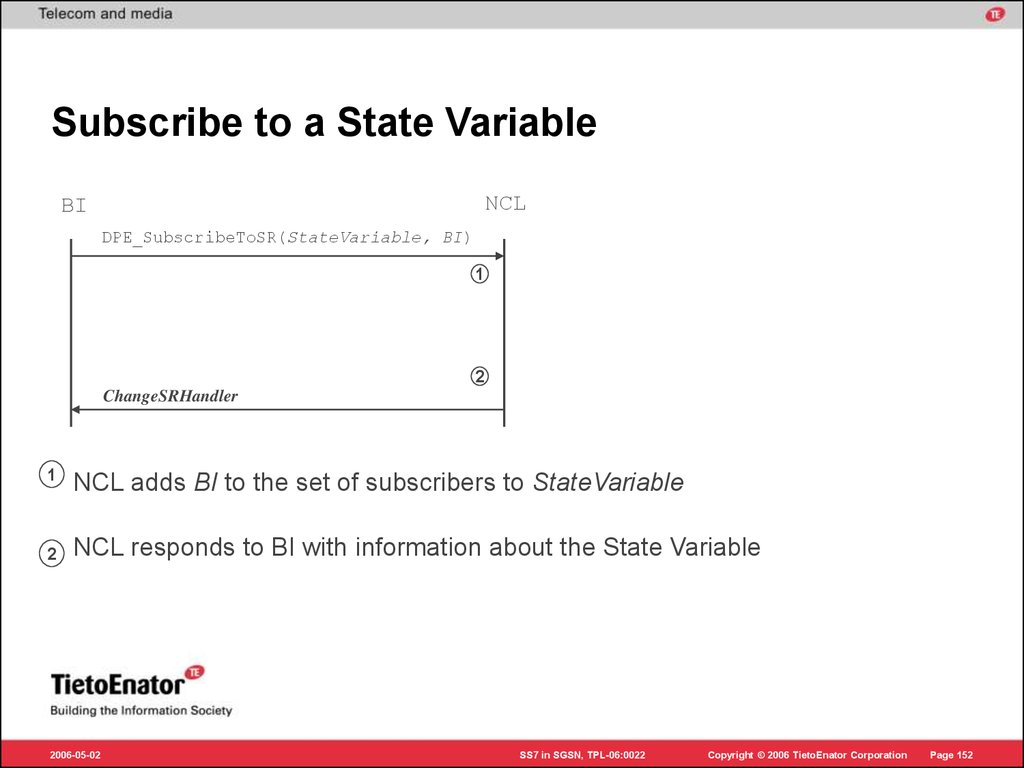

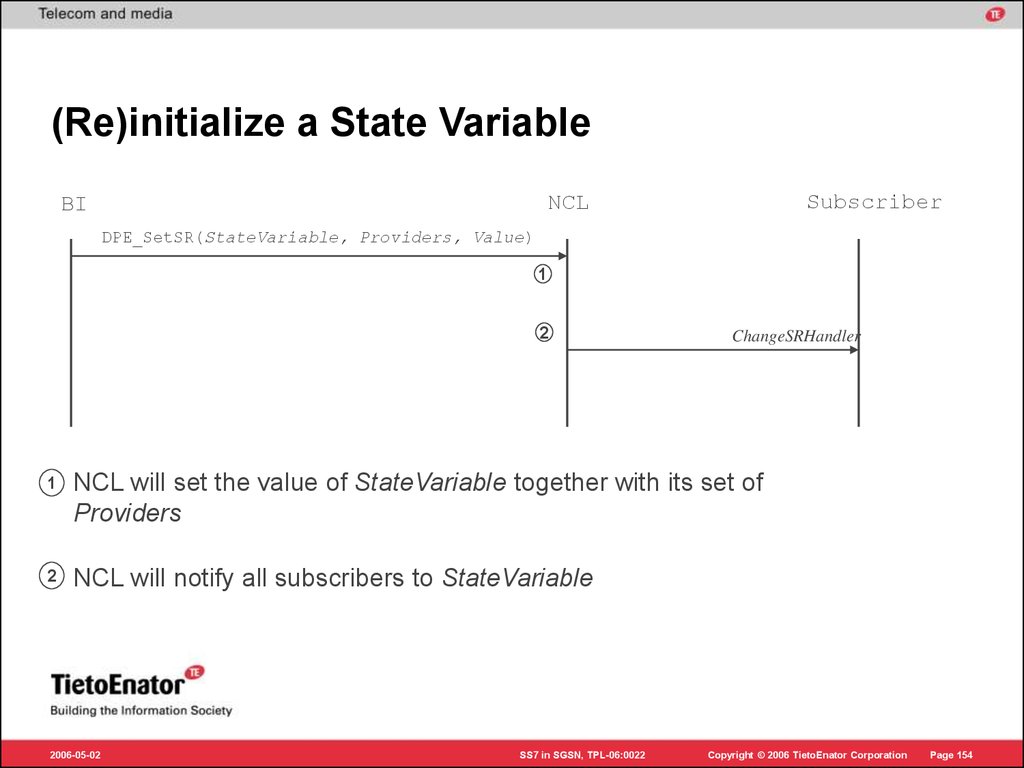





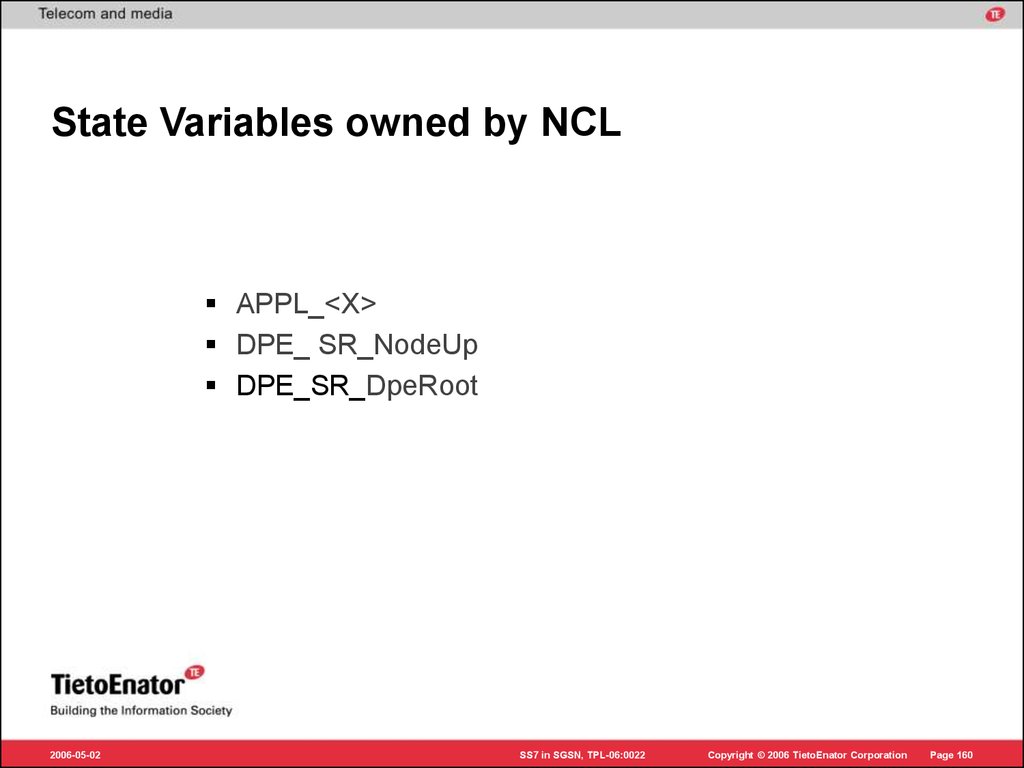
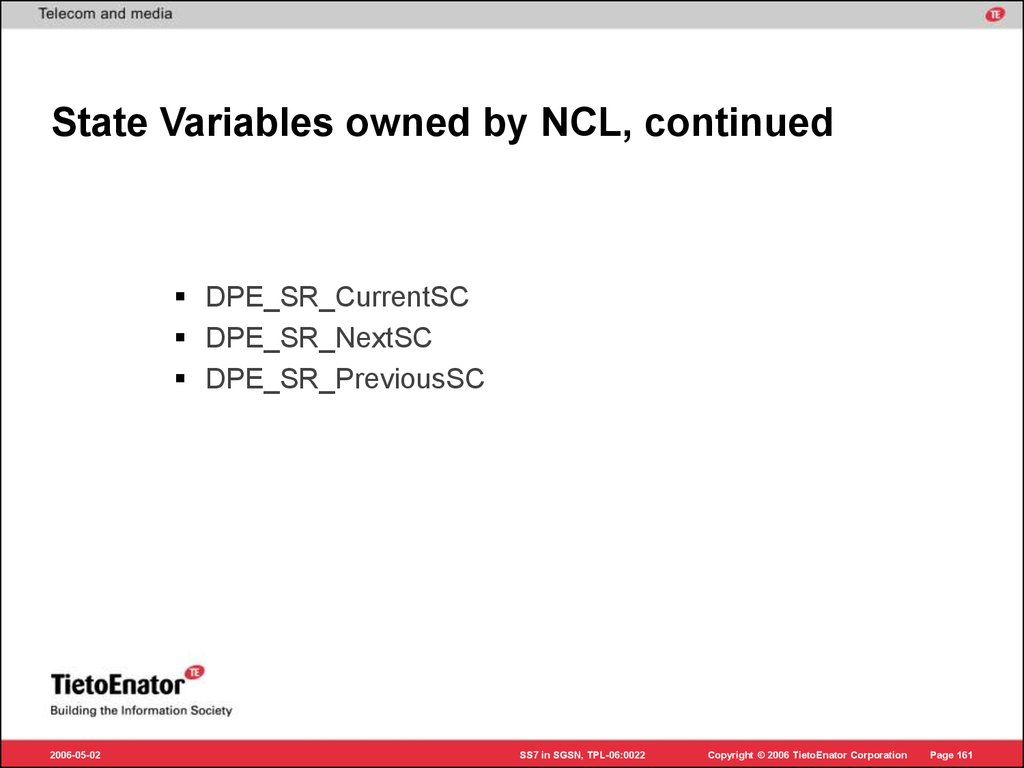





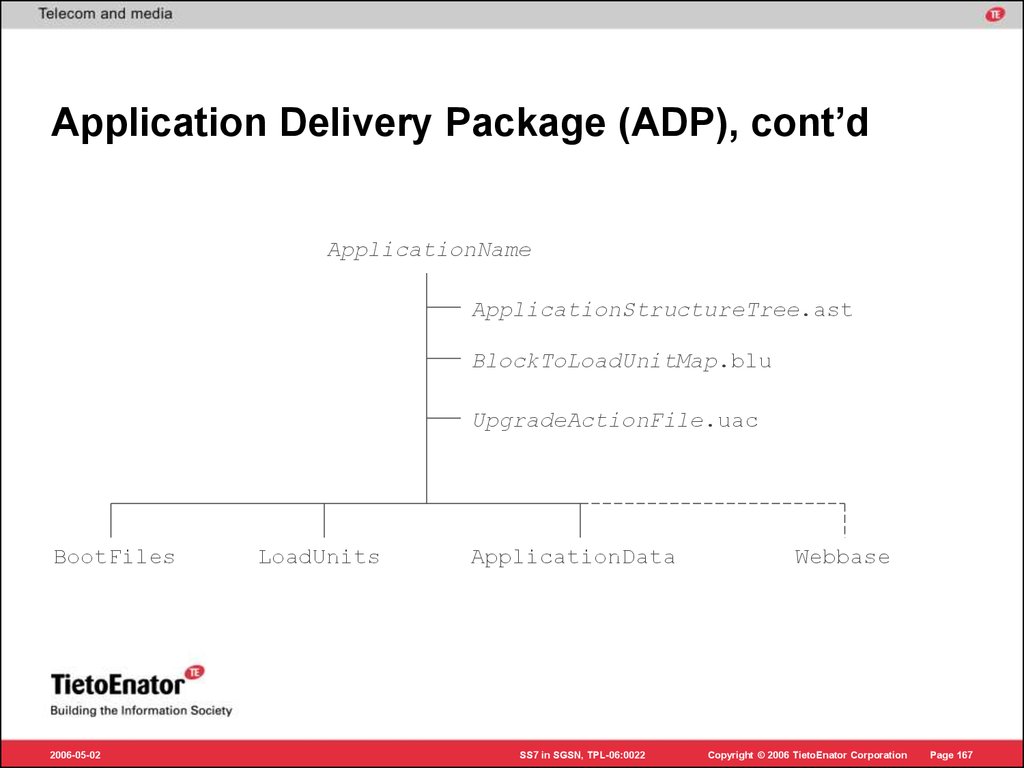



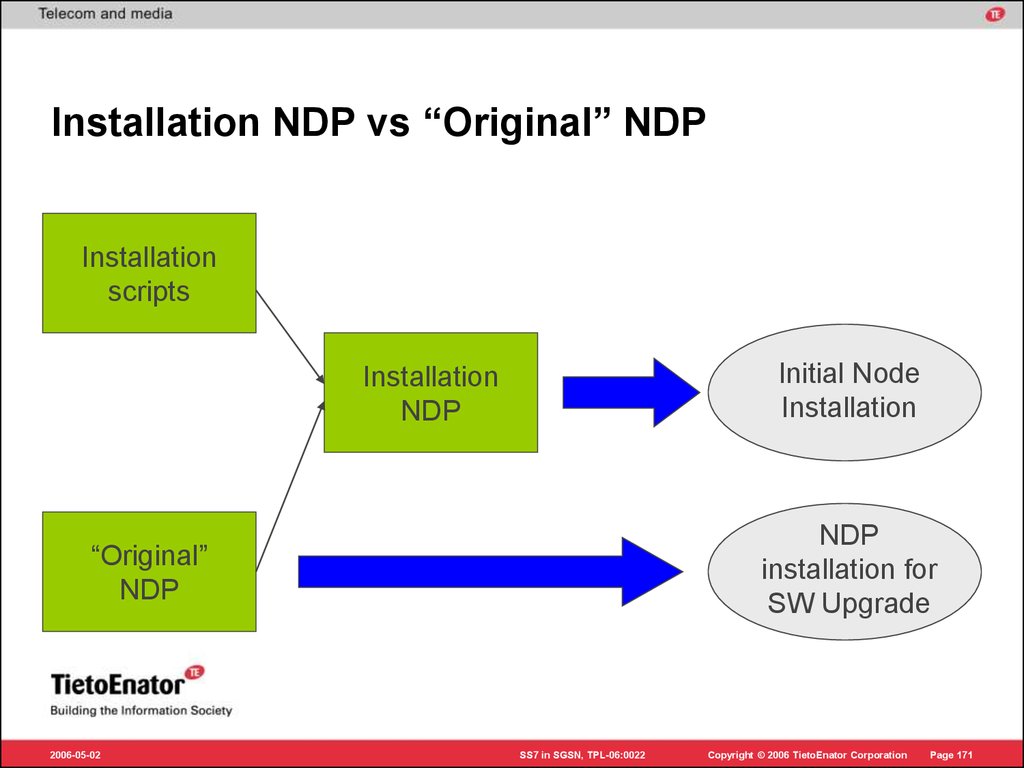




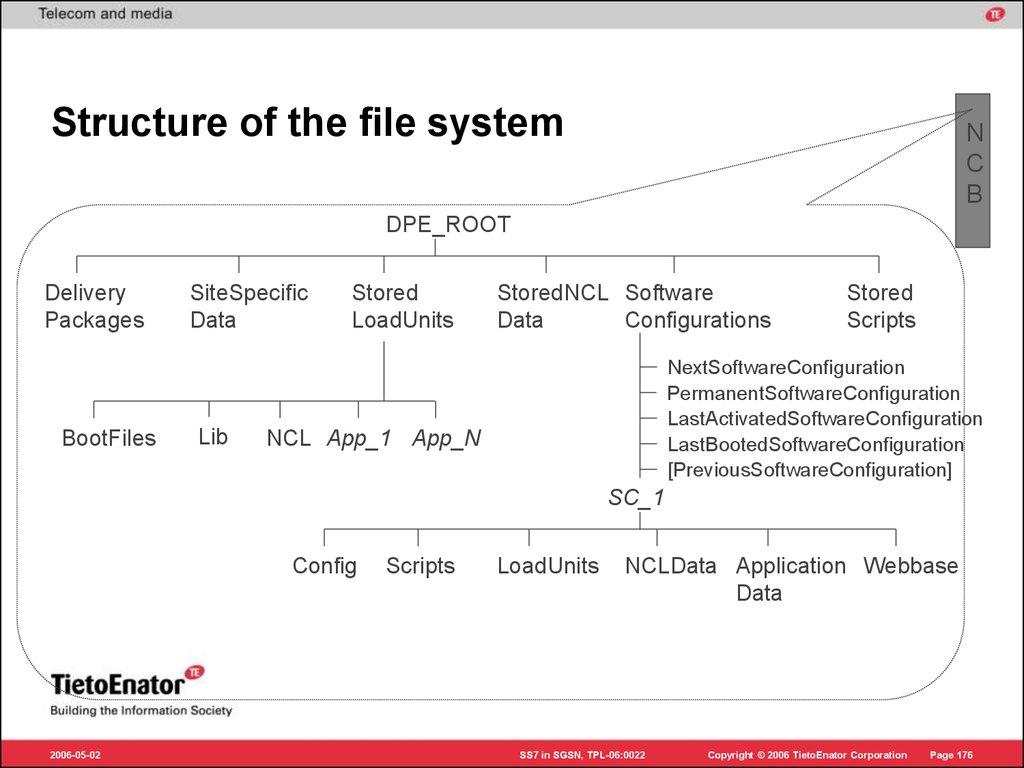
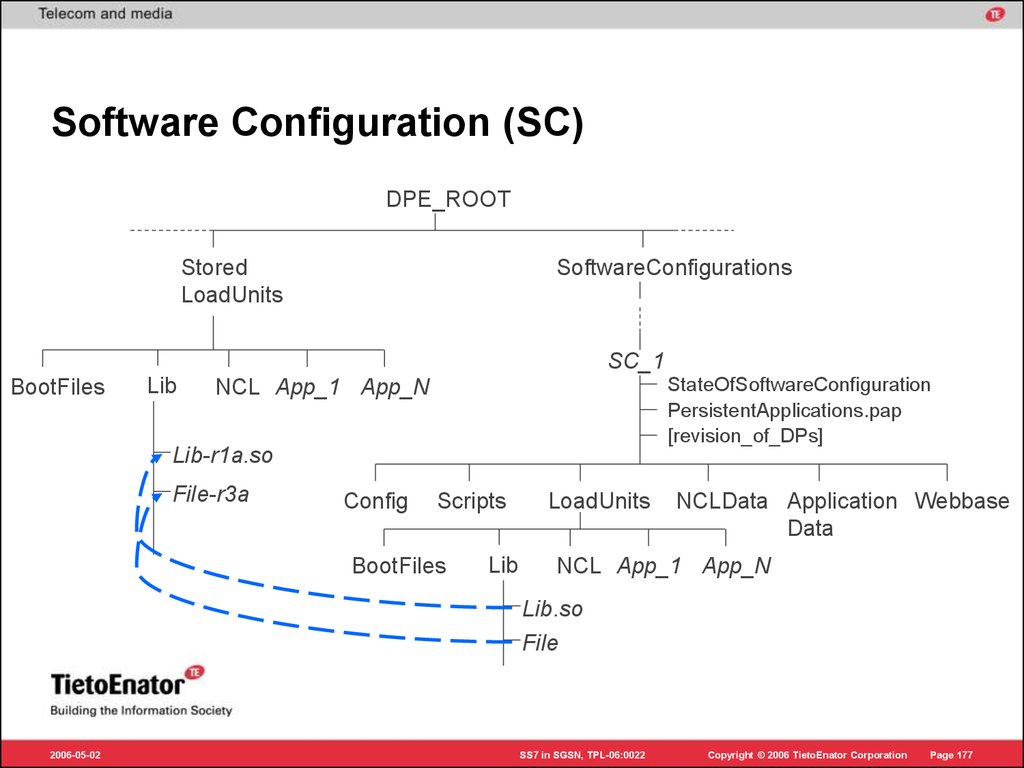
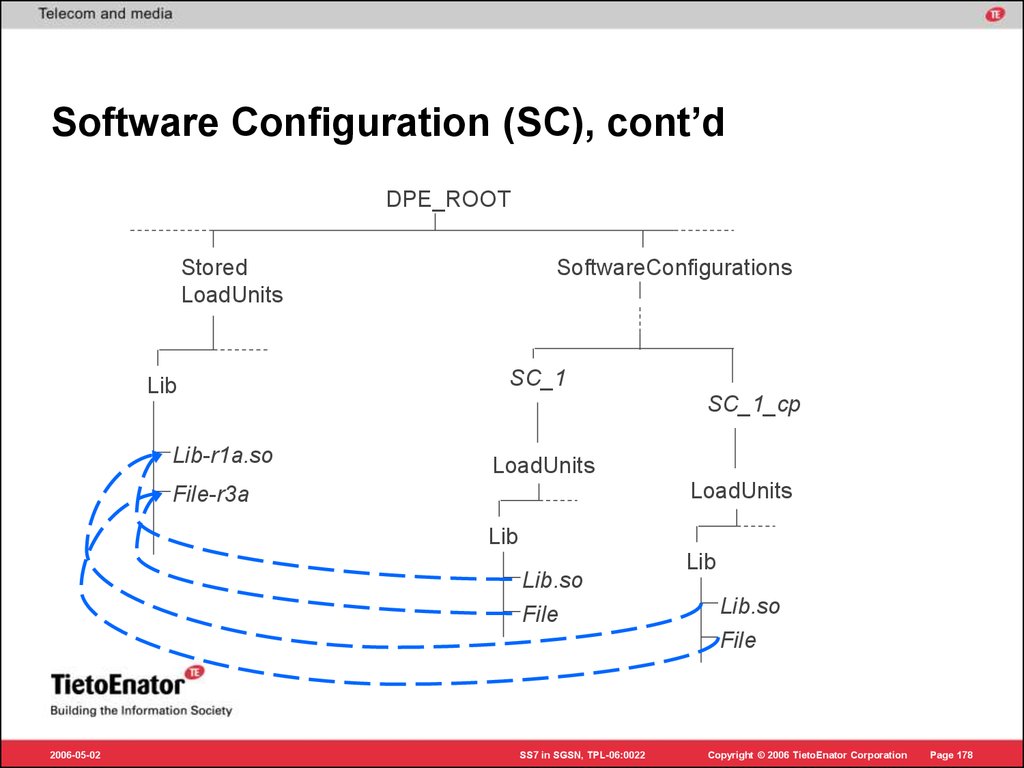
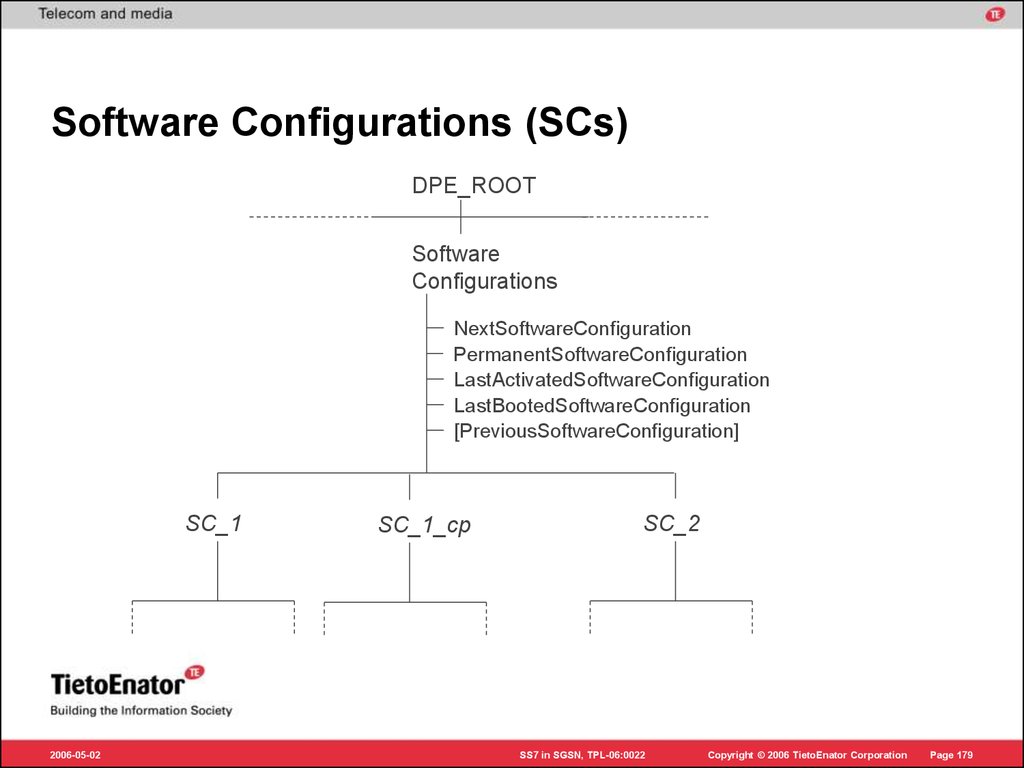


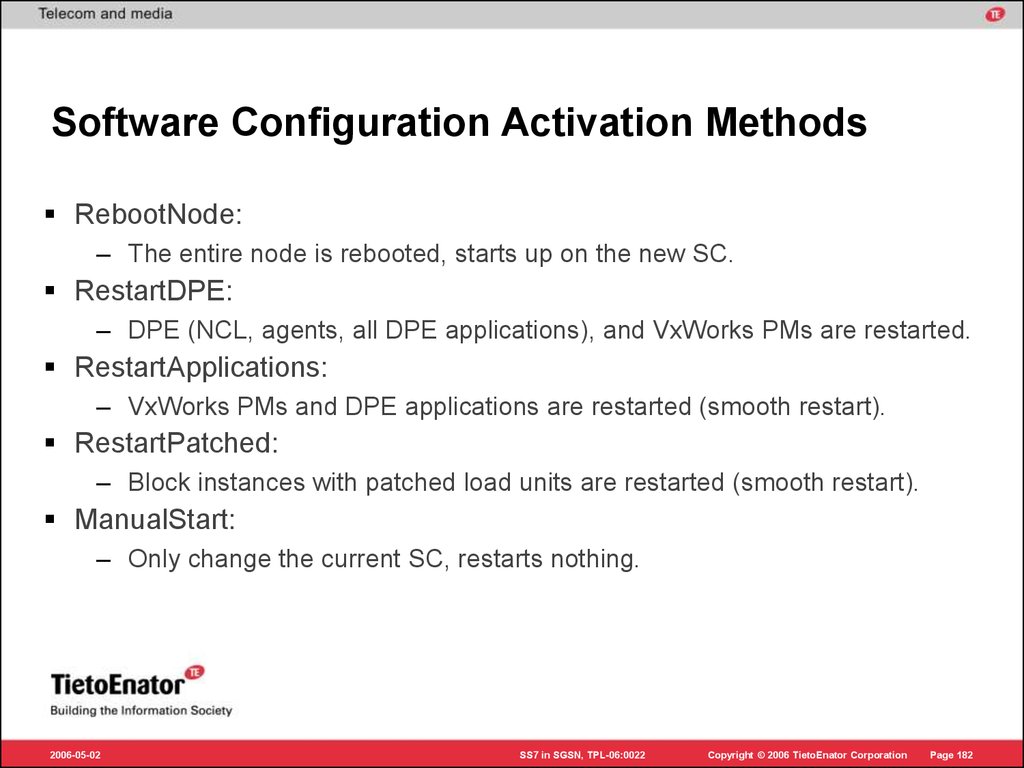
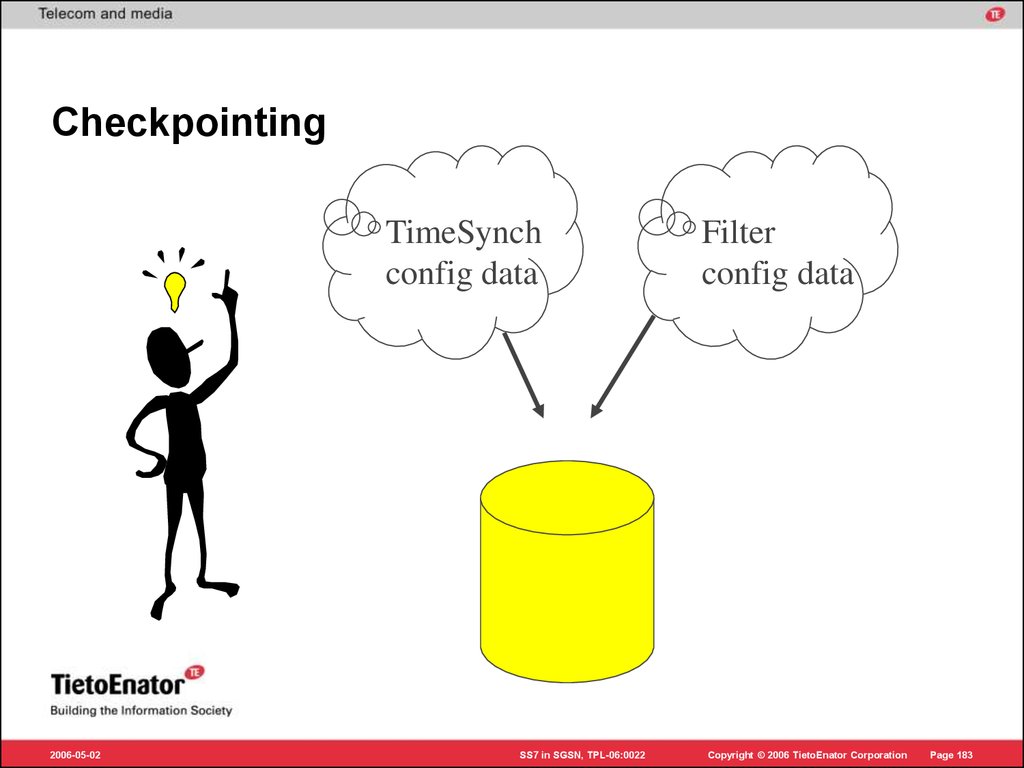
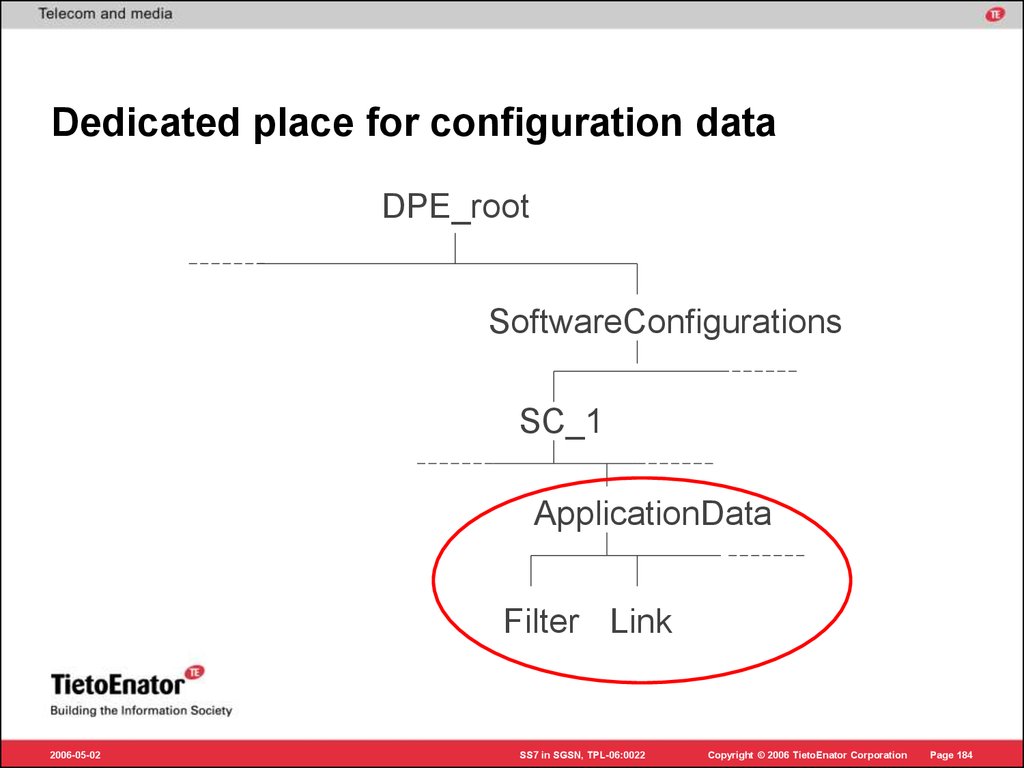

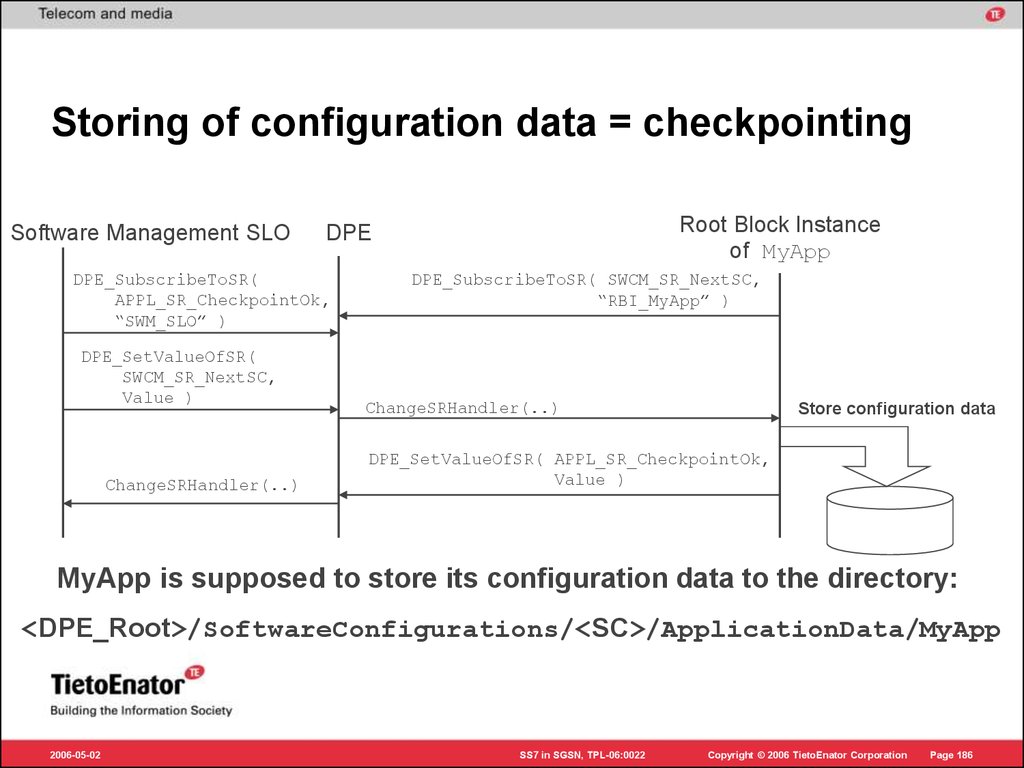
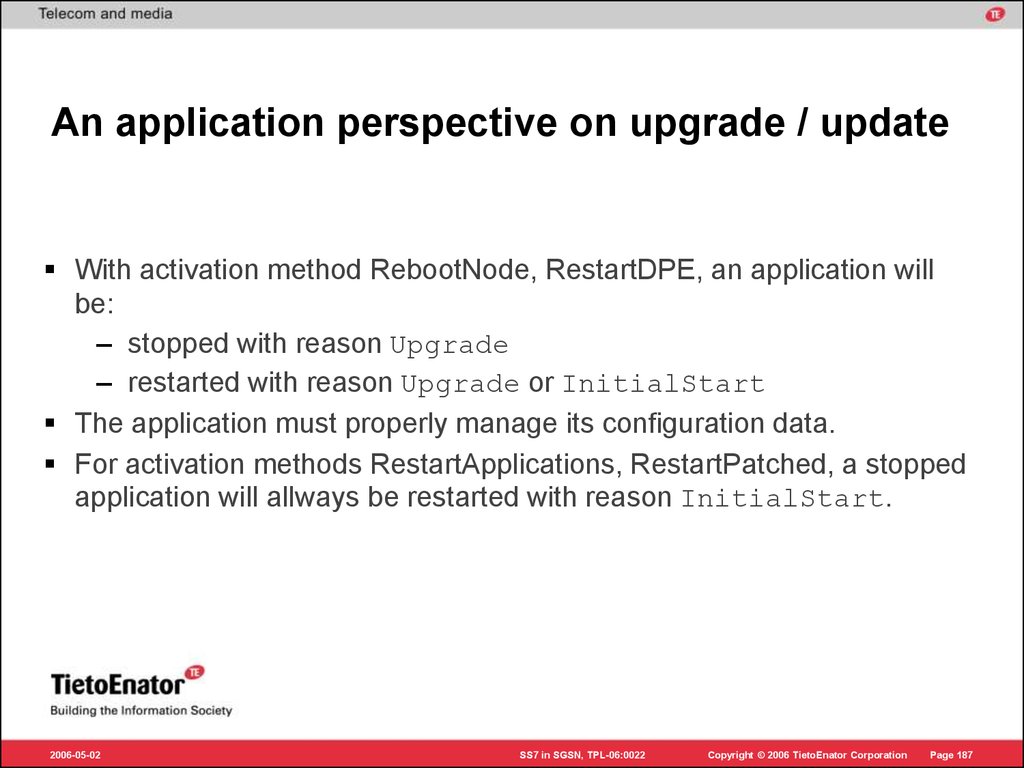

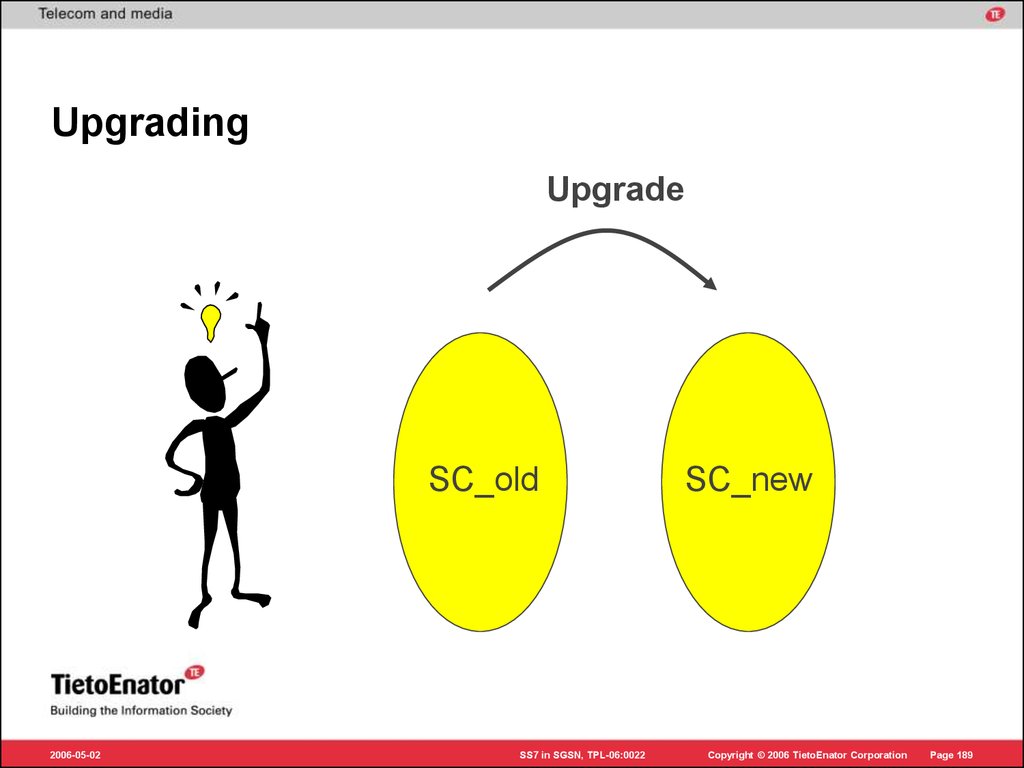
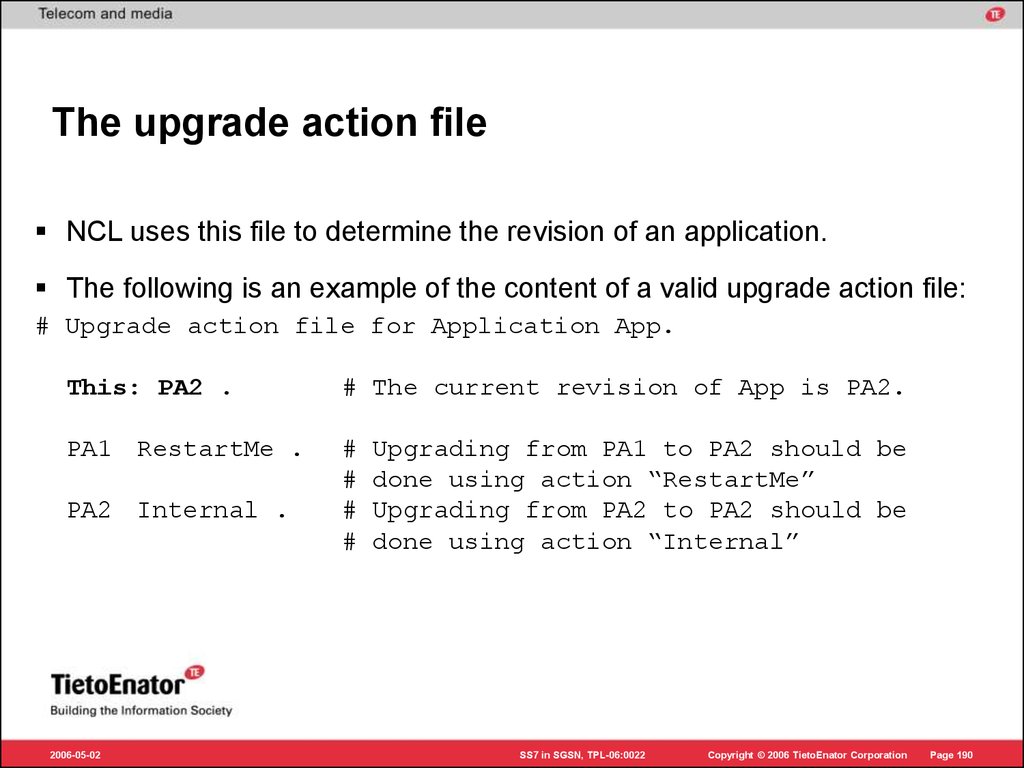


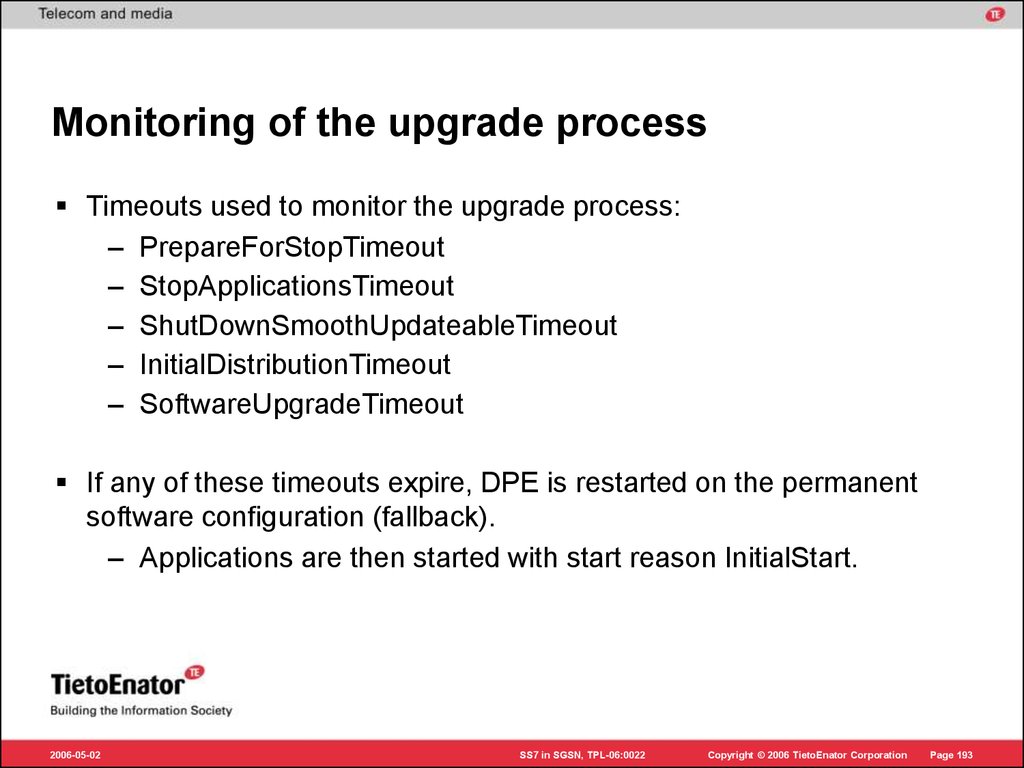

 Электроника
Электроника








